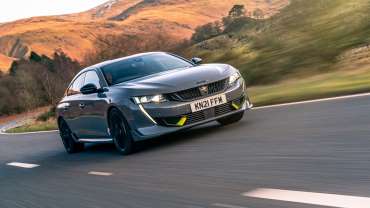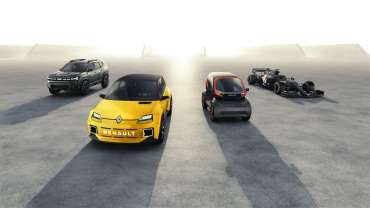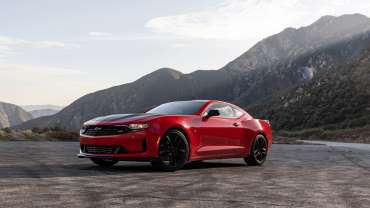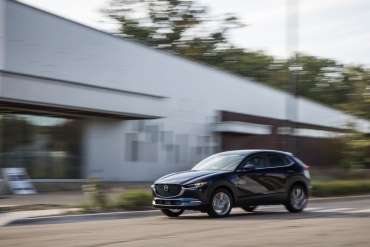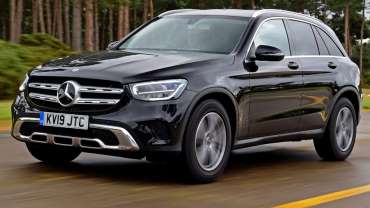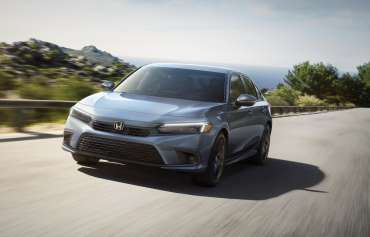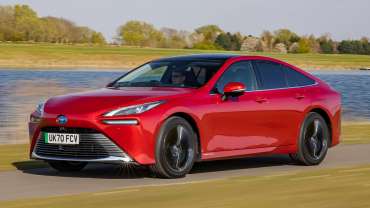
Worldcarblog.com
Peugeot 508 Sport Engineered (2021) review: the hybrid shapeshifter
Meet the many-hatted Peugeot 508 Sport Engineered – in one package a stylish fastback, business-class motorway cruiser, zero-tailpipe-emissions planet-pleaser and now, apparently, a powerful sports car.
That's a lot of plates to spin. So it won't surprise you to hear Peugeot's turned to a flexible plug-in hybrid powertrain to achieve it, promising more power than a regular petrol or diesel with the option to run emissions-free for a claimed 26 miles too.
Thing is, the 508 is mostly bought by company-car drivers, who usually only require a posh badge to impress clients, an M Sport bodykit to impress colleagues, and a small diesel engine to impress the fleet manager. Does the PSE model over-complicate things?
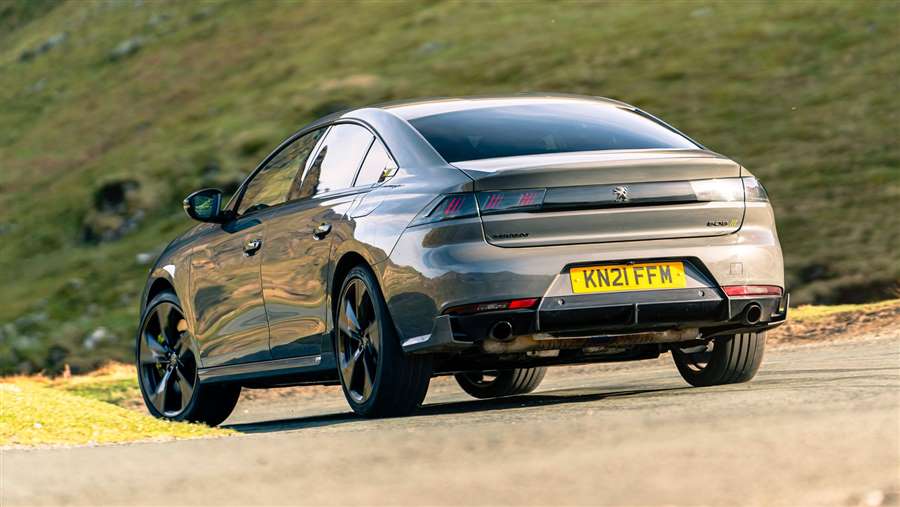
Who cares? It's a fast Peugeot!
Well yes, there is that, but consider the £50,000 price tag – for retail customers that puts the 508 PSE in the crosshairs of the BMW M340i and Audi S5 Sportback.
That's not an inherently difficult circle to square, because this is not only a fast Peugeot, but a very fast, very good Peugeot.
508 pse side pan
It's actually the most powerful roadgoing car the French maker has ever sold, in fact, with as much power in its electric motors as the 405 T16 we all so desperately want it to be.
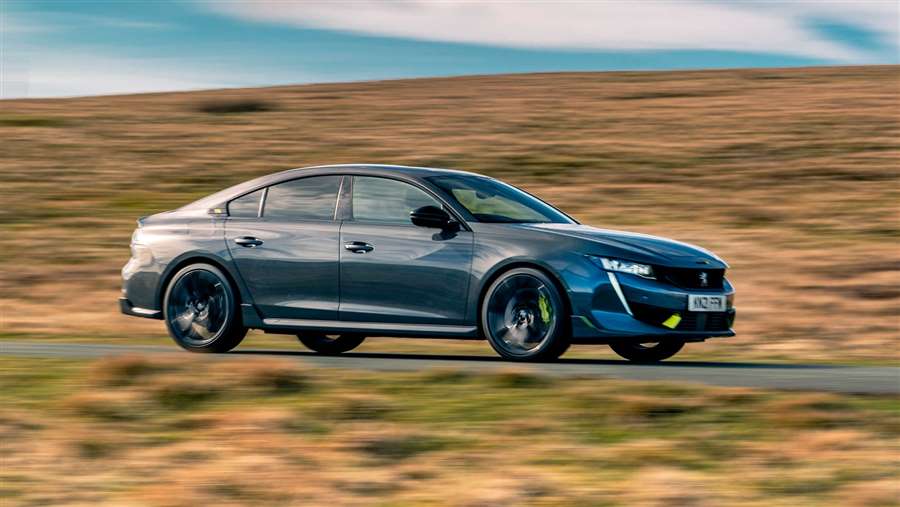
Why doesn't it have a GTi badge?
Peugeot says that's a question only British journalists ask, such is our love of the marque's heritage hot hatchbacks. But the 508 is something entirely different, offering a broader spread of talents than an out-and-out sports saloon.
The Sport Engineered name means it's a 508 first and foremost, with the benefit of being breathed on by Peugeot's go-faster division. It's WandaVision to The Avengers or The Mandalorian to Star Wars.
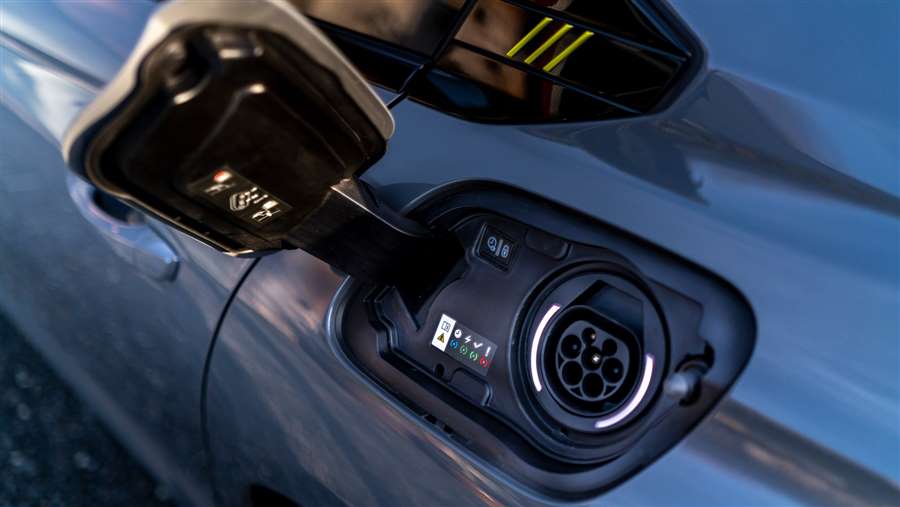
What's it like to drive?
Fast! But that shouldn't be a surprise, considering the 335bhp and 384lb ft of torque on offer from a 1.6-litre petrol engine and two electric motors, and an all-wheel drive system to help deliver it all cleanly to the tarmac.
It's not as fast as a pure-petrol M340i or S5 with those numbers, because it's heavier than a pure-petrol car. But it's not as heavy as you might imagine – the 1850kg kerbweight is actually pretty good for a PHEV.
The gearbox likes to shuffle up the cogs to save fuel (as is the way these days), but in Sport mode it seems to hang onto them for too long. The best solution is to use the column-mounted manual shift paddles, but these are too short and set too high – more suited to a ten-to-two driver than a quarter-to-three. Plus the left paddle is sandwiched between the left indicator stalk and cruise controls, and this is annoying.
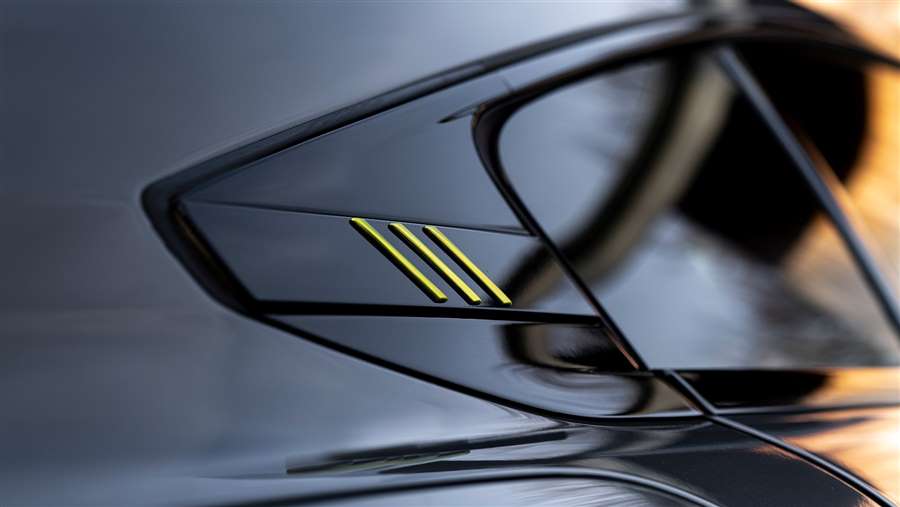
Things are better in the handling department where the 508 PSE is quite neutral in a corner and can be persuaded into a bit of lift-off oversteer as you'd expect in a car fettled by Peugeot Sport. This car is lower and wider than the standard model, and has its own springs, dampers and anti-roll bars.
The suspension is adaptive and offers a broad spread of settings, from comfy to firm, although there's always an edge to the ride that reminds you you're in the sportiest version. Otherwise it's typical Peugeot Sport – more hot hatch than a saloon, with light controls, a little bit of bodyroll, and agility and compliance to the ride, which adds huge fun on UK roads.
Only one thing stands out (and being a plug-in hybrid this won't surprise you): the brake pedal is spongy and hard to get dialled into. The 508 PSE is equipped with Alcon calipers and bi-material discs, which offer plenty of stopping power, but without mechanical pedal feel it can be hard to meter out.
How long does it take to charge?
The 11.5kWh battery takes about three to four hours to fill at the standard 3.7kW rate – a 7.4kW charger is an option, dropping the time to one hour and 45 minutes. Either way you only get a Type 2 cable, with no three-pin unless you pay for it.
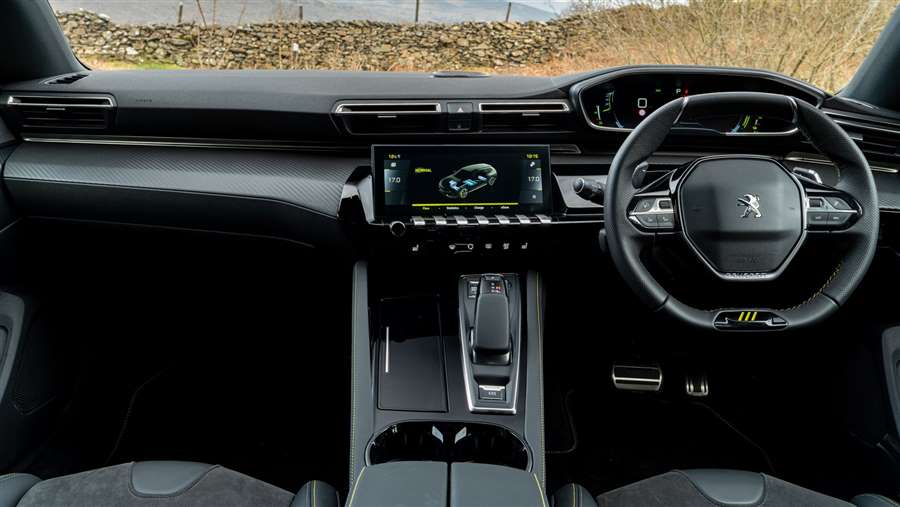
You need a full battery to get all 355hp, although with no charge the 508 will run as a sort-of hybrid in town, and on the whole it's pretty smooth and unobtrusive.
Pick up the pace, though, and you'll be greeted by the slightly reedy and over-synthesised tone of the petrol engine, which is alright when you want to cruise around in peace, but not very soul-stirring when you crack on. Still, that's another good reason to keep it charged.
Is it any different inside and out?
It's a pretty subtle change in exterior styling – from a distance – but as you get closer you'll notice all sorts of enhancements.
The most stand-out are the Kryptonite green additions, including the new claw logo, and the aggressive diffuser and aero ducting on the front bumper. Small vertical blades stick up on the edges of both and are probably more useful for tucking the cable into while the car's on charge than actually channelling air, but they're quite cool nonetheless.
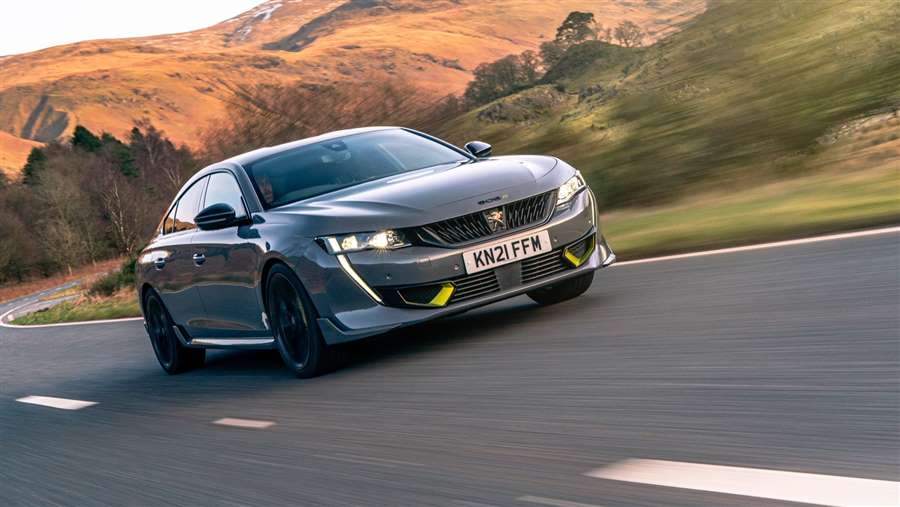
Inside, you still get Peugeot's divisive i-Cockpit layout with its tiny steering wheel set below the dials, but with more carbonfibre effect material. Overall it's a nice interior, very futuristic-looking, but the hard plastic used for the door bins and under the armrest stick out on a £50,000 car.
Peugeot 508 Sport Engineered: verdict
The 508 has been twice compromised in becoming this Peugeot Sport Engineered model – firstly by adding batteries and electric motors, and then again by giving it a performance focus.
What makes this car stand out against rival performance PHEVs is the fact it gives away very little in terms of outright practicality. The boot capacity is the same as a non-plug-in Pug at 487 litres, and despite being way more fun and accomplished to drive than the standard 508, it's barely any less comfortable day-to-day.
Yes, an old-school straight-six would be a more evocative powerplant, but the ability to drive emissions-free and the overall improvement in fuel economy in this 508 goes a long way to addressing that balance. It's an odd niche, but one that deserves plugging.
(carmagazine.co.uk)
What's new: By 2030, Renault will be the "greenest brand"
Renault is launching a new chapter dedicated to the modernization of the European car industry. At the online presentation, the head of the company Luca de Meo pointed out that out of 10 sold models, nine will have an electrified drive. Renaulution, as a strategic plan of the French company, includes a mix of hybrid and electric models. Seven e-models of the C and D segments will be presented by 2025, and the company's first coupe-crossover - Mégane Conquest marks the beginning of the sales offensive and will arrive in Serbia in June.
In the transition to the automotive industry, Renault intends to become the greenest brand in Europe by 2030, with 9 out of 10 cars sold being electrified models. In the field of technology and services, ie the project "Software Republique" will shape the future of urban mobility. More than 2,000 engineers from five leading companies in the industry will combine their knowledge in the fields of cybersecurity, artificial intelligence, data processing, software and microelectronics to create mobility solutions tailored to cities and local communities.
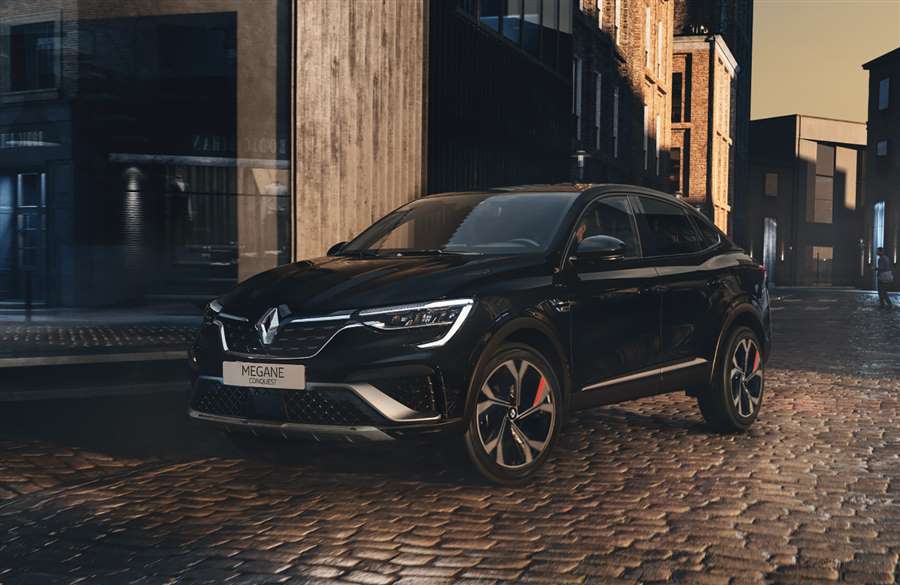
In addition, there is the Renault Re-Factory - Europe's first factory dedicated to the circular economy - marking the brand's turn towards a more sustainable and responsible business model with a total of 120,000 recycled or repurposed vehicles (including electric vehicles) per year. Almost 80% of the strategically recycled material will be reused in the new batteries. When it comes to the percentage of the use of recycled materials in new vehicles, Renault intends to take the first place by 2030.
The brand will conquer more segments with its "cars for life". Seven electrified C and D segment models will be introduced by 2025. The Mégane Conquest marks the beginning of a sales offensive.
The new generation Mégane E-Tech Electric, which will be an electric crossover, heralding the future of connected and fully electric vehicles, will also be introduced in the near future. Find out more about the new Megan here.
Finally, the E-Tech hybrid technology will experience further improvements in future models from segments C and D, primarily in terms of efficiency and fun driving characteristics. For now, in addition to the recently introduced Mégane Conquest, Captur E-Tech hybrid and Mégane E-Tech Plug-in hybrid, Renault has a total of six hybrid and plug-in hybrid vehicles.
With more than 10 years of expertise and almost 400,000 vehicles sold, Renault holds a leading position in the European electric vehicle market. Thanks to the experience in Formula 1, the brand has developed more than 150 patents that make hybrid technology efficient, fun to drive, with low CO2 emissions and low fuel consumption. This technology was introduced last year in three most important models: the Clio E-Tech hybrid, the Captur and the Megane Grandtour E-Tech Plug-in hybrids.
In the higher segments, especially the C-SUV segment, a new 1.2-liter three-cylinder engine combined with an electric motor will be introduced, with 200 hp for the hybrid version (2022) and 280 hp for the plug-in hybrid variant with all-wheel drive. (2024)
The first coupe-crossover with the Renault logo
It is the first C-SUV coupe to come with petrol TCe 140 and TCe 160 engines with 12 V microhybrid technology.
There is also a 145 hp hybrid engine that allows up to 80% of city driving on a fully electric drive.
2021 Chevrolet Camaro Turbo 1LE First Test: Its Own Thing
The four-cylinder 1LE delivers amazing handling and no messy tire smoke.
It seems that nearly every review of the Chevrolet Camaro compares it to the Ford Mustang and Dodge Challenger, and with good reason—these three nameplates are historic foes going back 50 years. Well, Constant Reader, that won't happen today, because the subject of this test is the four-cylinder 2021 Chevrolet Camaro Turbo 1LE, an endangered species that combines the Camaro's smallest engine with the SS model's suspension.
Truth be told, a read of the spec sheet had us thinking that this Camaro's natural enemies might be sport compacts like the Hyundai Veloster N and Volkswagen Golf R. Its 275-hp 2.0-liter turbo I-4, six-speed manual, and emphasis on handling over tire-smoking power would put it in the ballpark, we thought, but a couple weeks of real-world driving disavowed us of this notion. The Camaro 1LE has a very different character than a hot hatch. But it also has a very different character than the brawnier Camaros we've driven. We came away with likes, dislikes, a lot of respect—and a newfound notion that a Camaro equipped like this one really is its own unique thing.
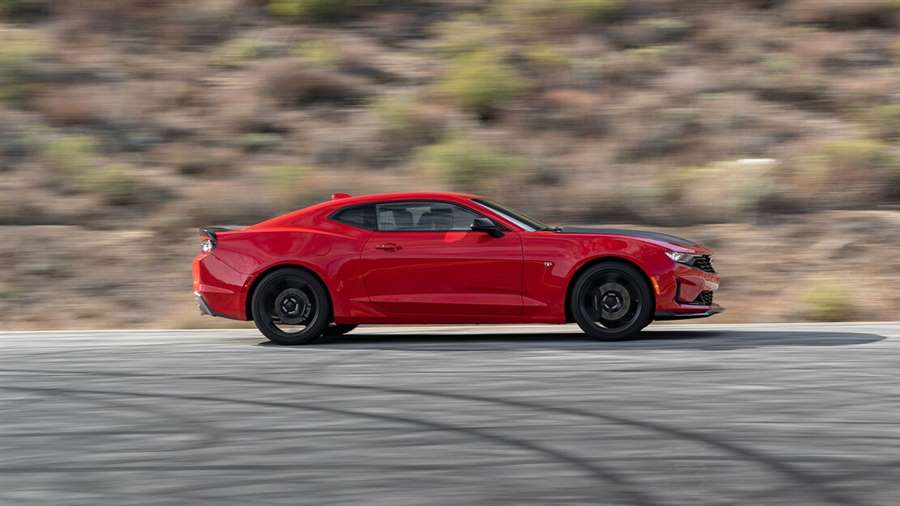
First, a little more about the Camaro 1LE. This is a track performance package that combines FE3 suspension components from the V-8-powered SS with four-piston Brembo front brakes, a mechanical limited-slip differential, a 3.27:1 final drive ratio, a short-throw shifter, and coolers for the engine oil, transmission, and rear differential. The V-6 Camaro 1LE also gets an extended engine cooling system and dual-mode exhaust. The 1LE's exterior elements include a black hood, black lightweight wheels, Goodyear Eagle F1 run-flat summer tires, and (strangely) RS badging.
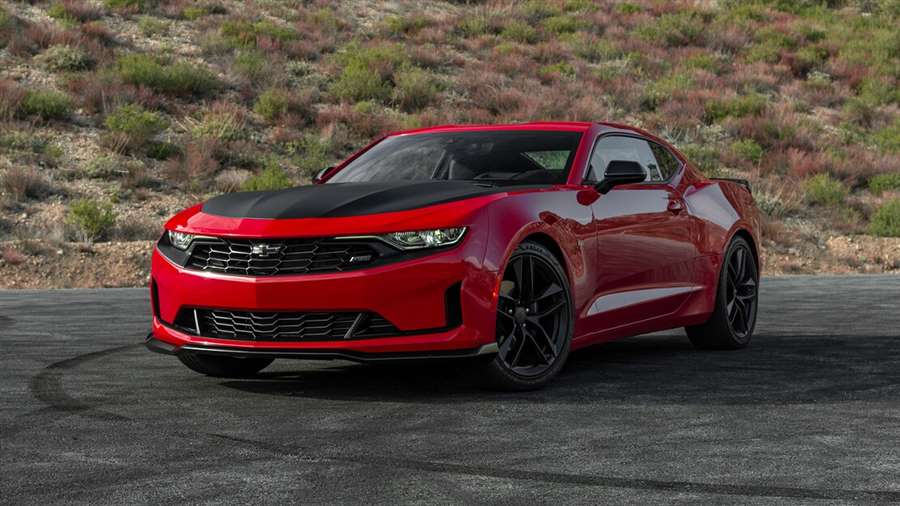
Turbo Four Is Small But Potent
As mentioned, our Camaro 1LE had the 2.0-liter turbo engine, which is the Camaro's smallest but not exactly its least potent. Although the 3.6 liter V-6 beats it on horsepower, with 335 to the 2.0T's 275, the four-cylinder's 295 lb-ft out-torques the six by 11 lb-ft. That said, the 2.0T is slower to 60 mph than either the V-8 (4.1 seconds with an automatic transmission) or the V-6 (5.0 flat with a manual). But a 5.6-second 0-60 time means the 2.0T hardly needs to apologize for its small displacement.
We found we could get quicker acceleration times by launching ourselves (revving to 4,000 rpm before dropping the clutch) rather than using launch mode. The no-lift-shift feature—in which you can keep the accelerator pinned to the floor while you shift gears, and the ECU will keep the revs where they need to be—proved to be a big help, as did the racing-style shift indicator on the head-up display.
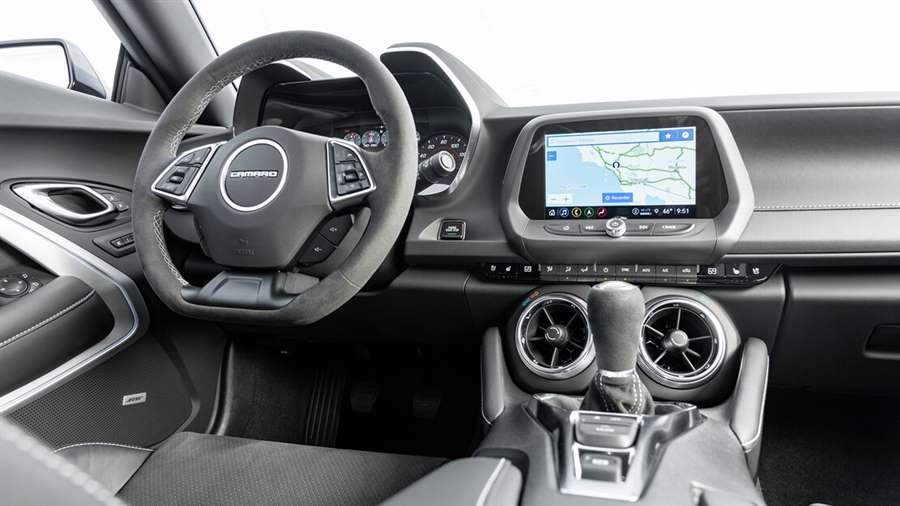
One quirk of the four-cylinder Camaro 1LE is its ridiculously tall gearing. Sixth gear is so high that it literally lugs the engine at 65 mph. Short of investing in a new gearbox, we suppose Chevrolet could fit a shorter final drive and improve the Camaro's sprinting ability, but then you'd run out of revs in first gear way too quickly. The gear spread and speed ranges feel perfect just the way they are, so we can live with a sixth gear that is only for cruising on superhighways. We rarely shifted above fifth and still managed better than 20 mpg.
1LE Means This Camaro Can Handle
But the 1LE is all about handling, and it was out on our favorite twisty roads that our affection for this particular Camaro really blossomed—and the differences between it and our favorite hot hatchbacks started to emerge. A good sport compact attacks the curves with a big, stupid grin, but the Camaro wears the concentrated grimace of a professional. It's not joyless, just focused.
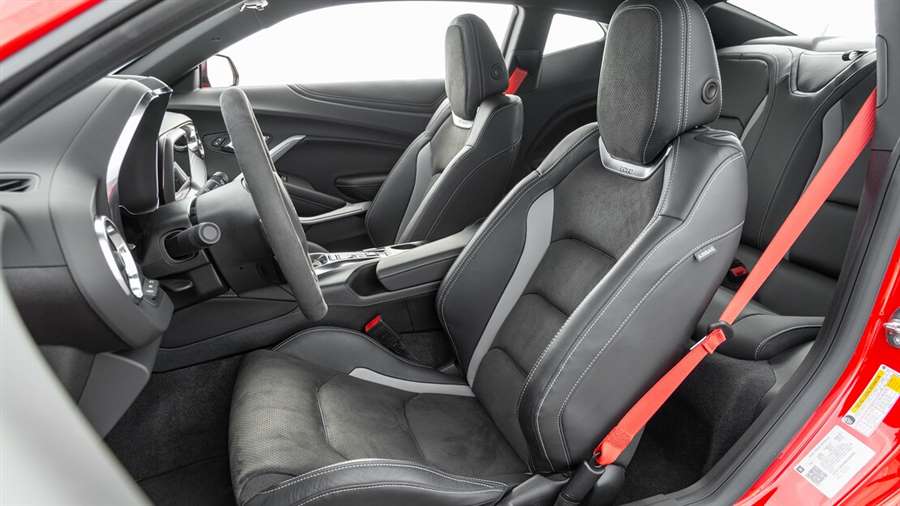
Like a good hot hatch, the Camaro's limits are high but accessible. It grips with heroic tenacity, though we were amused to note that on the skidpad, it was grippier in right turns (1.03 g average) than left turns (0.98 g average), something left-to-right weight distribution (49.9/50.1 percent) doesn't seem to explain—especially with the driver further loading the left side. Out on the open road, if you get cute and try to provoke the Camaro 1LE, it'll let go in an instant, especially if the tires are cold—but the telepathic connection between driver and car is so good that you'll likely have it gathered up just as quickly.
One of the key arguments in favor of the four-cylinder 1LE over other Camaro models is reduced weight on the nose, though we're not sure there's much real-world difference. Our test car weighed precisely 100 pounds less than the last V-6 manual Camaro we tested, but front/rear weight distribution was identical at 52%/48%. It's a different story compared to the V-8, which carries 54 percent of its weight on the front wheels.
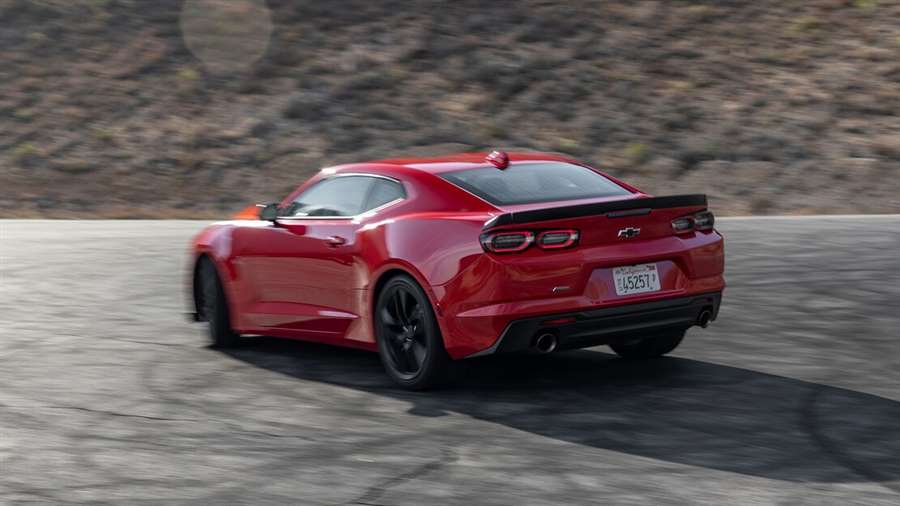
But whatever conversations are happening between the Camaro 1LE and Sir Isaac Newton, what the driver experiences is some kind of magic. Turn-in is buttery-smooth, and once in the curves the feedback from the steering is wonderful, with the front tires serving as your eyes and ears on the road surface. Rolling out of a turn, the steering does its best to guide you back to straight and true as you experience another benefit of the four-cylinder engine: You can open the throttle wide with no worries of the rear tires breaking loose and introducing an unwanted variable into your driving equation. Drag race with the V-8, but if your ideal road is curvy rather than straight, the 2.0T is the engine you want.
That is, most of the time.
Here's the problem: As much as we enjoyed, liked, and admired the four-cylinder Camaro 1LE on the curvy roads, it wasn't the fun-loving daily driver we were hoping for.
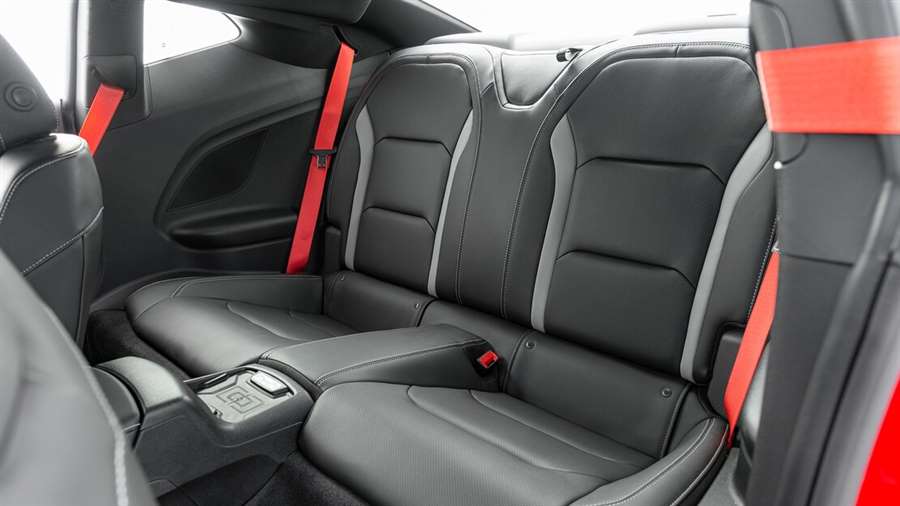
We all know the Camaro's built-in foibles: terrible outward visibility, awkward ingress and egress (exacerbated by our test car's $1,595 Recaro bucket seats), a strictly theoretical back seat, and a pint-sized trunk. That's not what we're talking about. And although it's easy to bag on the Camaro's cabin, we can't fault the ergonomics, driving position, or control layout. The touchscreen infotainment system is straightforward and easy to learn, and we love the climate controls—the idea of turning the chrome rings surrounding the vents into temperature controls is pure Joe Cool genius.
Our problem is that, unlike our favorite hot hatchbacks, the day-to-day driving experience is a bit, well, bleak. The 1LE isn't offered with an automatic transmission, which we love—but even for die-hard stick-shifters like us, the Camaro's heavy clutch and intractable shifter crowd the line between cheer and chore.
Sound, Or Lack Thereof
But the turbo Camaro's worst sin is its awful engine note. We know that a four-cylinder engine can't generate the deep rumble of a V-8, but with this 2.0T, it's as if GM's engineers didn't even try to make it sound good. Below 4,500 rpm all it can manage is an insipid, uninspired buzz that is too characterless to be called flatulent. Seriously, we cannot overstate how awful this engine sounds. We attempted to convey this to a car-enthusiast friend who expressed disbelief that any engine could sound as bad as we described—until we took him for a ride.
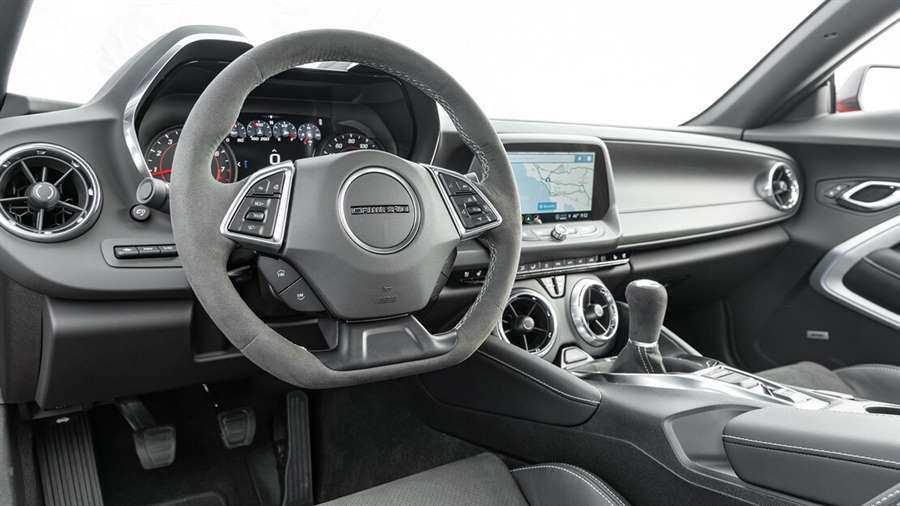
It's only in the top 1,000 rpm or so of its rev range that the Camaro's engine shows some aural promise, but given the flat torque characteristics and tall gearing, there's rarely any reason to rev it into the stratosphere. Come on, Chevrolet—Honda has been building awesome-sounding four-cylinders for decades. Even the Hyundai Veloster N makes better noises. We're giving you detention until you can work out how to make this thing sound like what it is—an honest-to-goodness performance engine.
Herein lies our one major issue with the four-cylinder Camaro 1LE: Not to keep dragging Hyundai into this, but the Veloster N is good fun whether you're tearing up the curves or running your kids to school. The Camaro is great when it's running hard, but we want it to be that much fun all of the time.
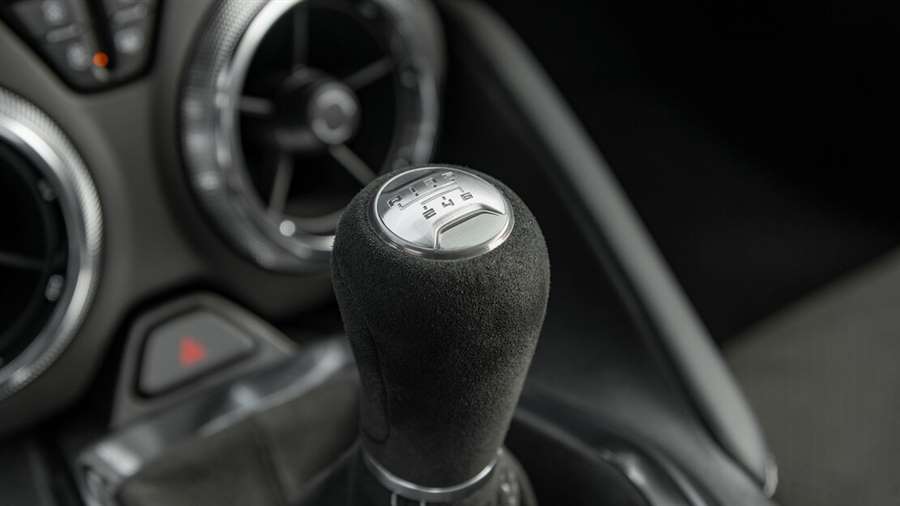
Would that make it a better car? It would be a more engaging one, to be sure, but perhaps that isn't what Chevrolet had in mind. The 1LE is, after all, meant to be a track package. What the four-cylinder Camaro 1LE does best is prove that the Camaro is truly a multitalented vehicle. It's not just a muscle car, and it's not quite a sport compact. Instead, the 2021 Chevrolet Camaro 1LE Turbo is truly its own thing—and that thing is pretty darn talented.
(motortrend.com)
Our 2021 Mazda CX-30 Impresses at a Leisurely Pace
Save for a misplaced plastic bucket in the middle of a highway, the first 10,000 miles with our Mazda CX-30 have been uneventful and about what we expected. We'll get to the bucket in a minute, but first let's talk about our initial thoughts on the CX-30—one specific to its segment, the other to the car itself.
As we see it, most small crossovers would work better as cars. In the case of the CX-30, the car it could be already exists: the Mazda 3 hatchback. But subcompact SUVs are popular, so Mazda created the CX-30, debuted it for the 2020 model year, and watched it sell more units than every other vehicle in its lineup except for the one-size-up CX-5. That pace hasn't changed this year. Through April, the CX-30 outsold both the Mazda 3 and the slightly smaller CX-3 crossover combined.
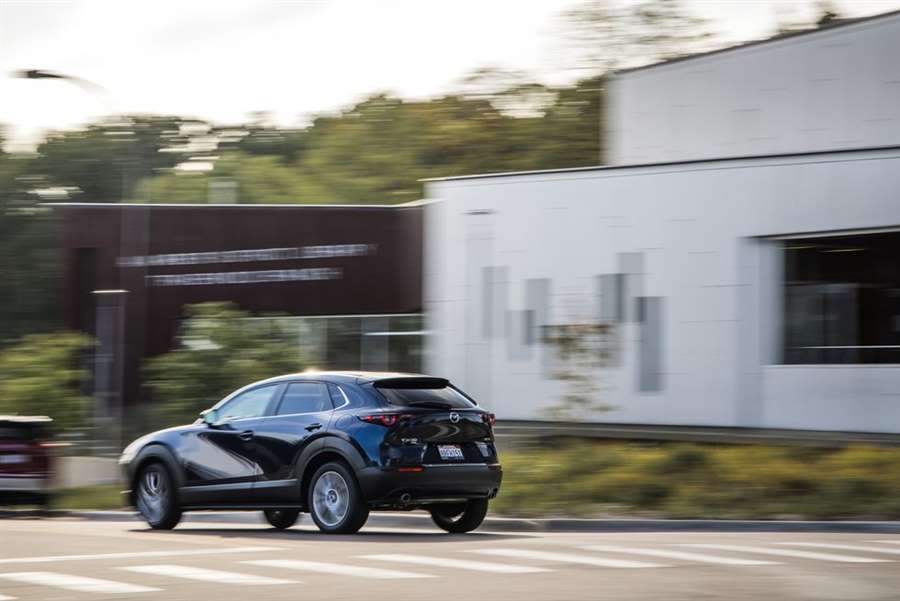
The only real change to the CX-30 for 2021 is the addition of an optional turbocharged 2.5-liter inline-four that produces 250 horsepower. Our long-term test car doesn't have that engine and, as we could have predicted, the Turbo model changes the SUV's math. In our testing, the boosted engine gets the CX-30 to 60 mph in 5.8 seconds versus 7.6 for our example with the standard 186-hp four. Just as noteworthy is the 1.1 seconds that the turbo engine lops off the regular CX-30's 50-to-70-mph time, which makes it far wieldier during passing maneuvers.
"Having spent a lot of time in the turbo version, not having the extra power really sucks the upscale vibe out of this thing," senior online editor Mike Sutton wrote in our CX-30's logbook. "It's quick and responsive enough, though. Good, linear steering and nice general body control. A good driver, but the same goes for the 3 hatch."
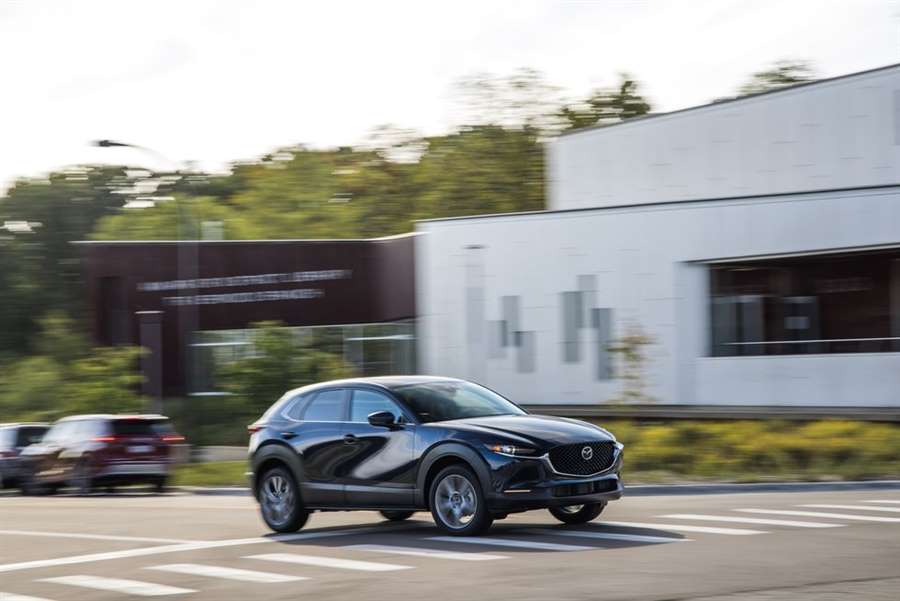
For C/D staffers less encumbered by seat time in the turbo, however, our regular CX-30 has quietly impressed as it's trekked up, down, and across Michigan. It hasn't left the state yet, but it's averaging a decent 27 mpg—1 mpg more than its EPA combined estimate—and summer road-trip season is nearly upon us.
Staff editor Eric Stafford took the CX-30 and his skepticism—"I haven't been a fan," he prefaced—on a nearly 2000-mile jaunt through Michigan's Upper Peninsula. He came away calling the vehicle "classy, sporty, and well equipped." The CX-30's 20 cubic feet of cargo space was sufficient for his needs, and he found enough back-seat room for adults. "While the 2.5-liter is gruff when pressed, it's plenty potent and operates quietly enough in normal driving," he wrote. Indeed, our Mazda's 68-decibel sound measurement at 70 mph is the same as the Turbo model's, and it puts the CX-30 in the company of the Mercedes GLA250. "Too bad its driving range is short. I averaged right around 300 miles per tank, which required extra stops on my long trip."
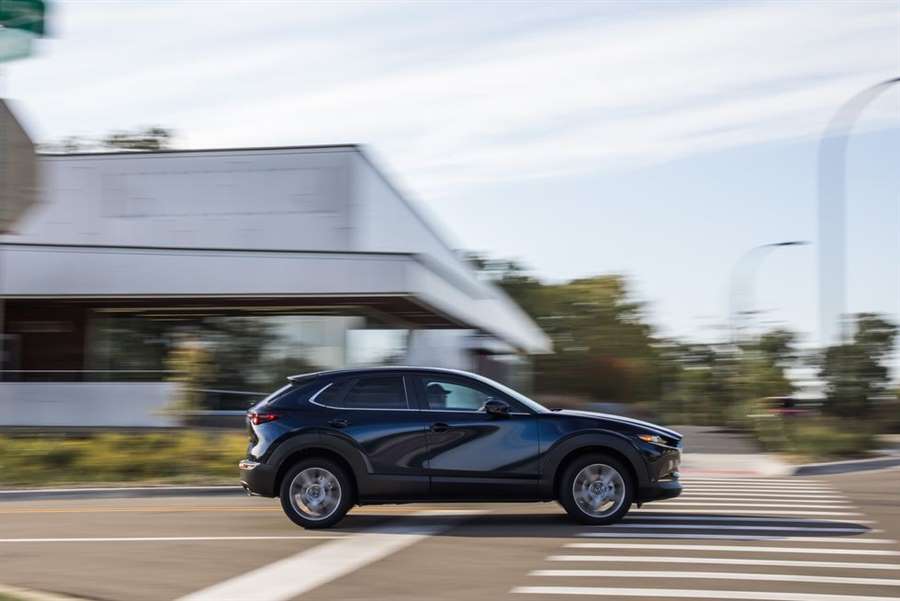
A few other criticisms have creeped into the logbook. The sometimes wonky activation of the car's automatic high beams can make for a challenging drive on foggy nights. The CX-30's adaptive cruise control sometimes will brake harder and more suddenly than we expect when approaching slower vehicles. "You should never design a heated seat control near a cupholder," noted creative director Darin Johnson. He didn't elaborate, but we assume he cleaned up whatever he spilled reaching for the seat heaters.
But our first 10,000 miles have largely been spent pondering how the CX-30 fits in Mazda's lineup, as well as how it stacks up with competitors such as Kia's Soul and Seltos and Hyundai's Kona and Venue. "I don't see why some people are confused about the CX-30's mission," buyer's guide deputy editor Rich Ceppos wrote. "It's the right-sized subcompact SUV that the CX-3 should have been in the first place—the cargo-friendly analog to the Mazda 3 sedan."
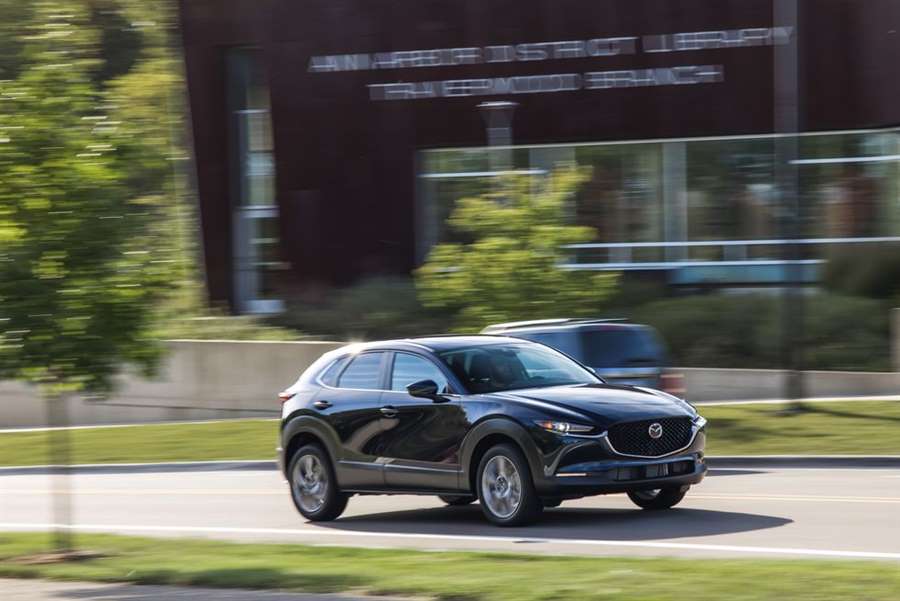
As for that bucket, it was blue, plastic, and it appeared out of nowhere on our local stretch of M-14. Ceppos, stuck in the center lane, didn't have any choice but to hit it. The result was a baseball-sized hole in the plastic panel under the CX-30's nose. We had the dealer inspect the damage when we dropped the vehicle off for its scheduled 10,000-mile service, which included an oil and filter change and a tire rotation at a cost of $107. Replacing the panel relieved us of another $93 and entailed an overnight stay while the replacement part was ordered.
Aside from that mishap, it's been a solid start to the CX-30's 40,000-mile test. "Sweet steering, sharp throttle response, fun handling—yep, this is a Mazda alright," Ceppos wrote. His only suggestion? It could benefit from the turbocharged engine.
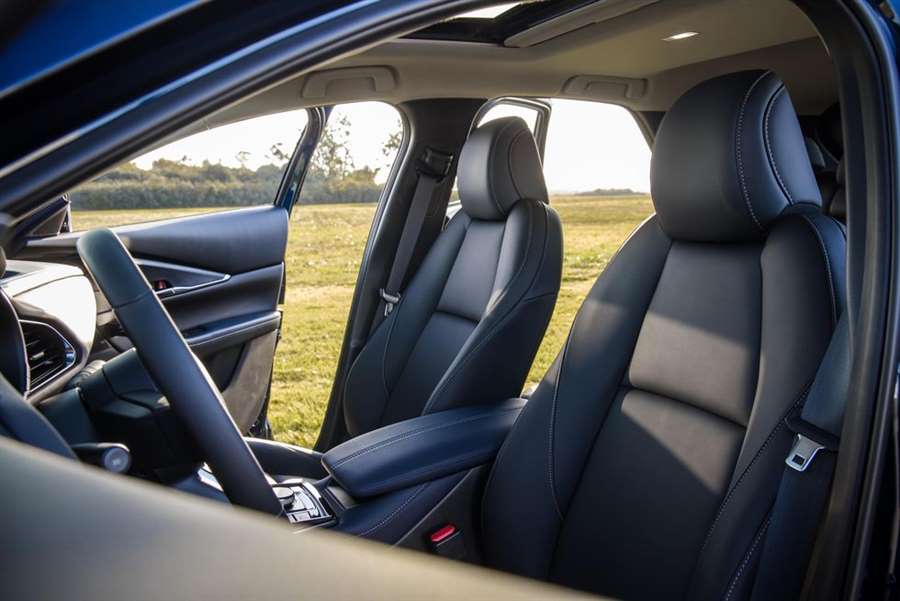
Months in Fleet: 7 months Current Mileage: 10,696 miles
Average Fuel Economy: 27 mpg
Fuel Tank Size: 12.7 gal Observed Fuel Range: 340 miles
Service: $107 Normal Wear: $0 Repair: $0
Damage and Destruction: $93
Introduction
In 2019, when we took the keys to a CX-5 for a 40,000-mile long-term test, we wrote that "Mazda has few obvious problems." The CX-5 supported that conclusion, proving "easy to love," earning 10Best honors in 2020 and 2021, and exhibiting uncommon excellence despite belonging to a segment we generally greet with a resigned sigh.
We tolerate compact SUVs because they're popular, but we celebrate Mazdas because they're good. The tension between those ideas, plus the rising popularity of small SUVs, makes for interesting work. The CX-5 won us over. So, let's up the degree of difficulty.
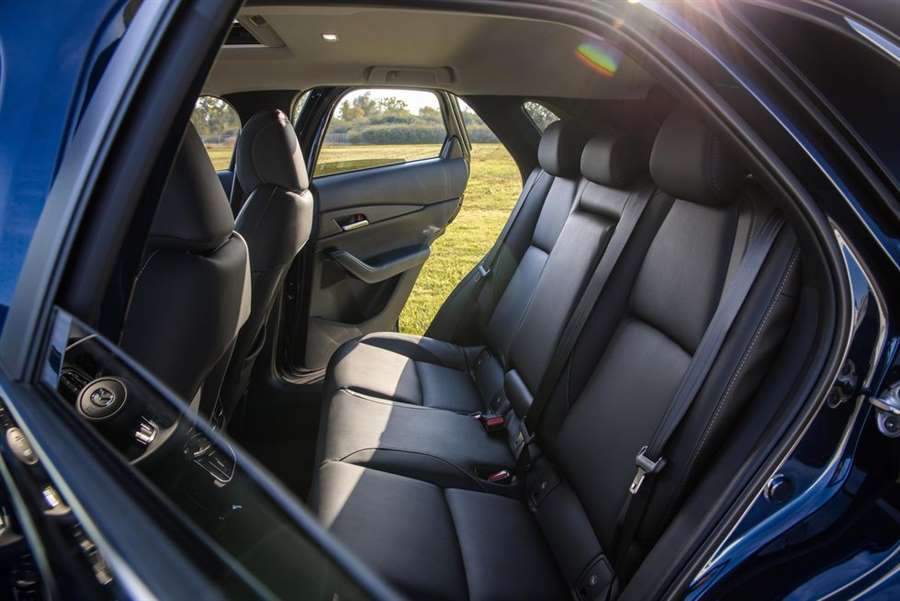
The CX-30 is a subcompact SUV, a segment that typically prompts a single frustrated question: Why aren't you a car? Recall, if you will, our review of the 2020 CX-30, which began, "Have you considered the Mazda 3?"
The 3 is roughly the same size as the CX-30, give or take a tuck or tweak here and there, and it's available as a hatchback. We like the 3 a lot. Despite already building the 3 and a similarly sized crossover, the CX-3, Mazda introduced the CX-30 for 2020. Why? Because people like to sit a little higher these days, and higher sells.
Any other reasons? We're about to find out over 40,000 miles with a 2021 CX-30. Now in its second production year, Mazda didn't change much from the CX-30's debut run except to add an optional turbocharged 2.5-liter engine that's good for 250 horsepower.
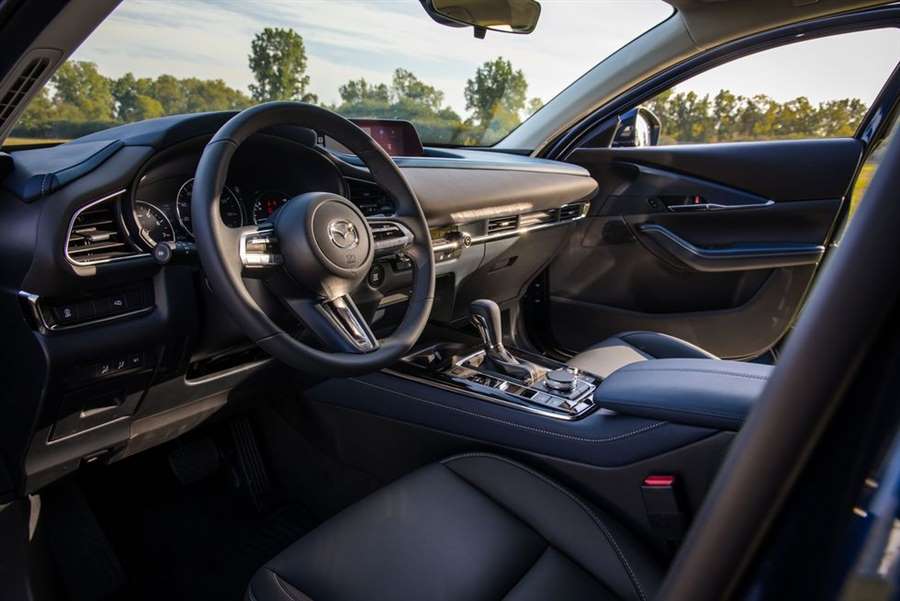
"I heard we got the non-turbo," staff editor Austin Irwin messaged shortly after the CX-30 arrived. To ensure his feelings were clear, he punctuated the sentence with a sad-face emoji.
We did not get the turbo. Sad-face emoji.
Our all-wheel-drive CX-30 came with the standard 2.5-liter inline-four and six-speed automatic transmission. It makes 186 horsepower and ran to 60 mph in 7.6 seconds in our initial testing. It hit the quarter mile in 15.9 seconds at 89 mph and pulled 0.85 g on the skidpad. Those are decent numbers. The Mazda 3 2.5 Turbo we recently tested did zero to 60 mph in 5.6 seconds. Just pointing that out.
The CX-30 starts at $23,000, which is $155 less than the "all-wheel drive is standard" base Subaru Crosstrek and $4390 more than the "it's front-drive or no drive" Kia Soul. There's value in the CX-30 in either direction, even when tacking on the $1400 for all-wheel drive.
We got the Preferred Package, which includes a power driver's seat, memory positioning for the exterior mirrors, heated front seats, a power sliding-glass moonroof, and driver's seat memory. But we stayed light on options for this one. We picked up all-weather floor mats ($150) and a rear bumper guard ($125). That's it. The as-tested price totaled $29,075. We took delivery and promptly set about running SUV-like errands in our SUV-like car (or our carlike SUV).
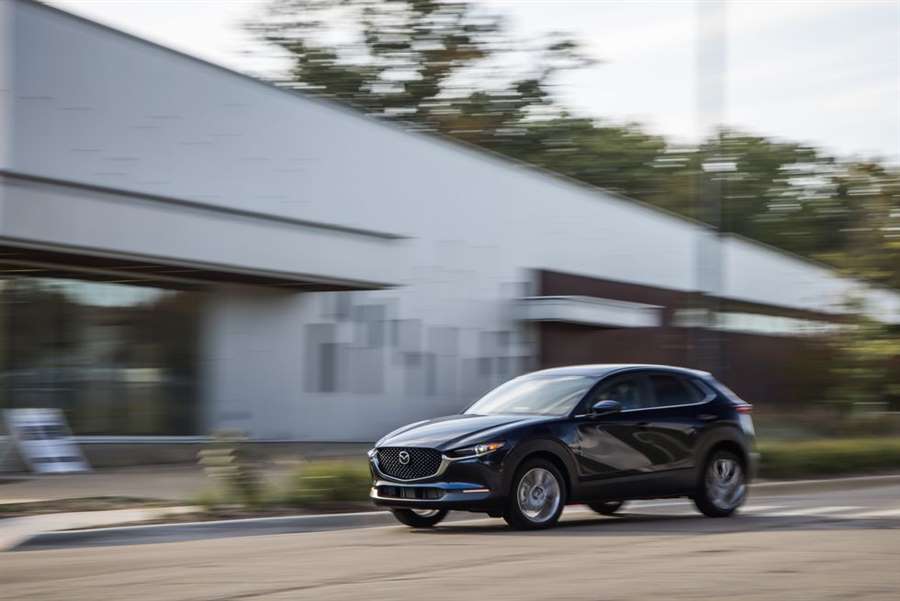
The first coffee spill came on a run to City Hall to drop off a ballot. The first grownup shunted to the back seat (kids are quick to grab the heated front passenger seat) surveyed her surroundings and said, "They make the most of the space they've got back here." A quick run to the driving range revealed that golf clubs fit in the aft cargo area without folding the rear seats. Barely.
Since we're still working from home, we ran some simulated commutes through town, out on country roads and on the highway. We recommend the country drive, especially in autumn. It's lovely, and there are just enough twists and turns to prove the CX-30 moves like a Mazda. It's playful enough to be fun.
The black on navy interior with leatherette seats and a leather-wrapped steering wheel makes for high-quality company. The 8.8-inch infotainment screen is fine, and Android Auto and Apple CarPlay come standard at the Select Package level. (That's one down from our Preferred.) The Deep Crystal Blue Mica paint job has already earned compliments. If there are quirks to be found, our planned lap and a half or so around the Earth should shake them out.
"Such a comfortable little medium SUV" begins the first entry in the logbook, which brings us back to our 40,000-mile challenge: What exactly is the CX-30, and why does it exist?
We had a different CX-30 at this year's 10Best testing and comments ranged from "true to the Mazda ethos" and "much more in the realm of Audi and BMW than Chevy and Toyota" to "just get the Mazda 3."
Have you considered one of those?
Of course, you have. Through October, Mazda sold nearly 28,000 3s in North America in 2020, but that's down almost 37 percent from the same point a year ago. The CX-3's sales numbers this year are also down, by 27.5 percent (7485 sold). The upshot for Mazda is that those declines could be ascribed to the appeal of the CX-30, which moved 31,007 units through October. In the Thunderdome of Mazda dealerships, the CX-30 is thriving, and Mazda buyers appear to (narrowly) prefer it to the 3. We'll let you know if there needs to be a recount.
Months in Fleet: 2 months Current Mileage: 3597 miles
Average Fuel Economy: 28 mpg
Fuel Tank Size: 12.7 gal Observed Fuel Range: 350 miles
Service: $0 Normal Wear: $0 Repair: $0
Damage and Destruction: $0
Mercedes GLC SUV review
“The Mercedes GLC is an SUV that benefits from a lot of C-Class pedigree, but with a raised ride height and improved practicality”
Mercedes has had a car battling against the BMW X3 and Audi Q5 since 2009, but to UK buyers this may not have been obvious because the old GLK-Class was only sold in left-hand-drive markets. However, since 2015, the GLC, which replaced the GLK, has been sold here and is an SUV version of the popular Mercedes C-Class saloon on which it’s based.
Mercedes gave the GLC a mild facelift in 2019, which involved some tweaks to the exterior design, some new engines and a plethora of technology upgrades inside. The updates were needed given how competitive the SUV market had become, and 2021 ushers in a plug-in hybrid version for the first time too.
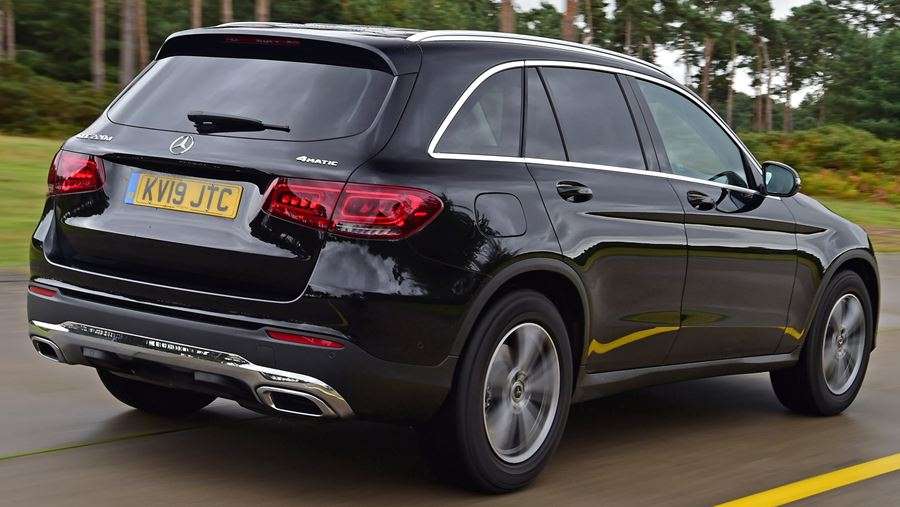
Best 4x4s and SUVs
The revised GLC borrows engines and equipment from the C-Class. The similarities between the two models are harder to spot in style terms, however, unlike the Mercedes A-Class and GLA, which have more in common. The GLC is an attractive car in its own right, with the latest design including slimmer headlights and tail lights, and the latest Mercedes grille.
Every GLC comes with Mercedes' 4MATIC four-wheel drive and a smooth nine-speed automatic gearbox as standard. Versions badged 220 d and 300 d are fitted with the same 2.0-litre diesel, but tuned differently to produce 191 and 242bhp respectively. The 220d returns up to 45.6mpg and has CO2 emissions starting at 175g/km, while you can expect 42.8mpg and 184g/km from the 300 d, which are competitive figures. These are trumped by the GLC 300 e plug-in hybrid model, which can manage 26-31 miles of electric range and 122mpg. What’s more, its low CO2 emissions mean company-car tax is a third of the petrol and diesel engines.
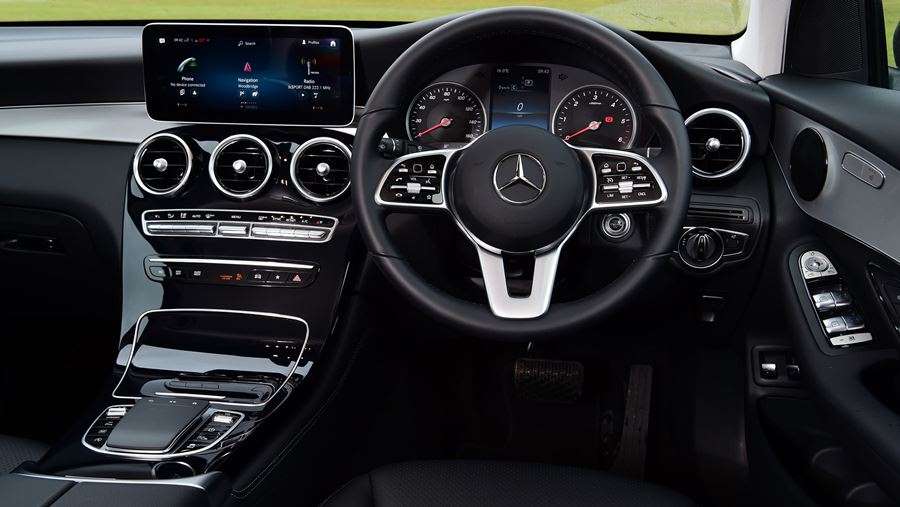
A clear highlight of the GLC is its attractive and well built interior, which also has enough room for front and rear occupants to be comfortable, along with heater controls for people sitting in the back, which is surprisingly rare. There are lots of thoughtful cubbies and the 550-litre boot puts the GLC in the same territory as the X3 and Q5, while the Discovery Sport is more practical and has the option of seven seats.
The introduced the latest Mercedes MBUX infotainment system, but unlike all-new models, there's still a tablet-style central screen perched on the dash, that looks slightly incongruous. The software is a major upgrade, though, and the main screen now responds to touch as well as the central control pad. A regular set of dials are standard, while a large 12.3-inch digital version is available as an option.
On the road, it soon becomes apparent that Mercedes concentrated on comfort when developing the GLC. It’s very smooth on the standard suspension and even more cosseting if the optional air-suspension is fitted. Drivers on the hunt for thrills may feel short-changed, though – while the Volvo XC60 is even softer, the newer BMW X3 is more responsive and poised on a country road.
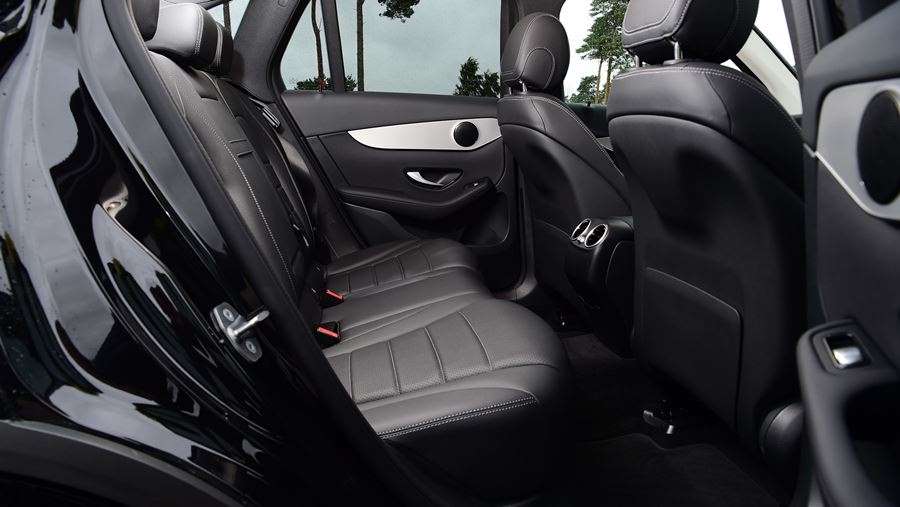
There are effectively three trim levels, consisting of the core AMG Line trim, plus Premium and Premium Plus versions. The 220 d engine is only available in AMG Line Premium and below; the more powerful 300 d is the AMG Line Premium and up. Desirable items like a powered tailgate, reversing camera and Artico leather upholstery are all included, along with sat nav and LED headlights. AMG Line Premium GLCs gain distinctive body styling and an interior makeover, as well as even bigger 20-inch alloy wheels.
AMG Line is now the most appealing trim for company-car drivers and we'd recommend spending the extra monthly finance cost for private buyers too, to benefit from all the GLC has to offer. The Premium equipment line includes adaptive headlights, running boards, a larger instrument display, ambient lighting, augmented reality navigation, Android Auto and Apple CarPlay compatibility and wireless smartphone charging.
Before it was facelifted, the GLC came 61st out of 100 models in our 2019 Driver Power customer satisfaction survey, but reliability wasn't a strong point, so owners will be hoping issues have been remedied. Further peace of mind should be provided by the GLC’s five-star Euro NCAP crash-test rating.
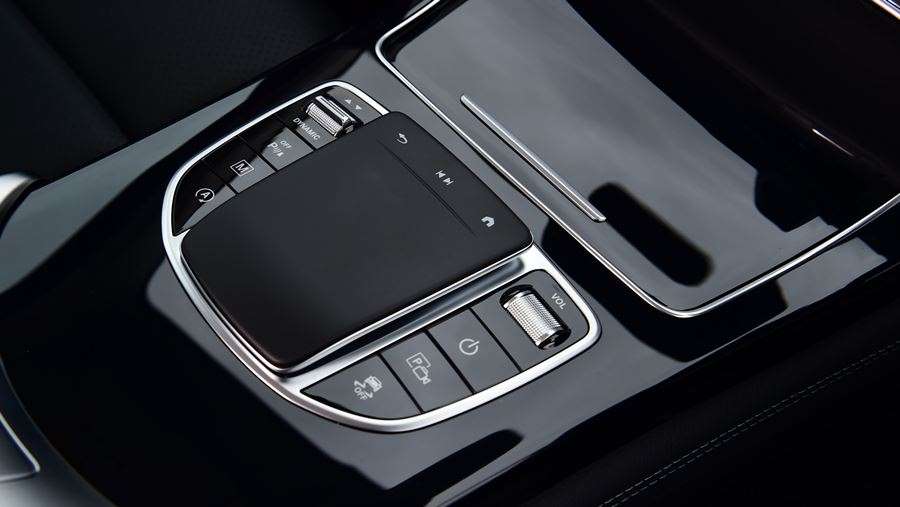
Mercedes GLC SUV - MPG, running costs & CO2
SPECIFICATIONS
The Mercedes GLC is pretty economical for an SUV, with its claimed figures rivalling the likes of the Audi Q5 and BMW X3. Mercedes also offers competitive warranty and servicing plans.
Mercedes GLC MPG & CO2
The 220 d version of the 2.0-litre diesel engine can return up to 45.6mpg, reducing slightly in top trims with optional wheels fitted. CO2 emissions of 175g/km mean it sits in the highest BiK band, which won’t appeal to company-car drivers. The more powerful GLC 300d is a shade less economical, at up to 42.8mpg, with emissions of 184g/km. By comparison, the BMW X3 xDrive 30d offers more pace and returns 46.3mpg with 159g/km.
Petrol engines are offered too. A GLC 300 model promises up to 33.6mpg, while the AMG 43 and 63 models above are even thirstier. They certainly prioritise speed over running costs; you can expect 26 and 22mpg respectively. All petrols are in the top BiK band.
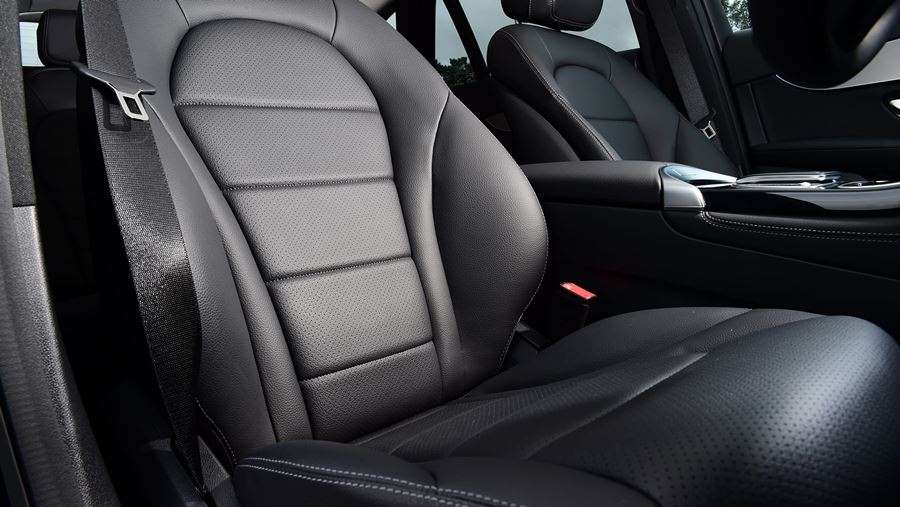
A plug-in hybrid GLC 300 de version is now available, pairing the 2.0-litre diesel engine with a 13.5kWh battery. It offers 27 miles of electric range and up to 156.9mpg if you regularly recharge the battery, while business users will be drawn to its 12-13% BiK rate. It’s also exempt from the London Congestion Charge until October 2021. In 2021 it was joined by the GLC 300 e, with a petrol 2.0-litre engine and an electric range of 26-31 miles. It can officially manage up to 128.4mpg with emissions of 62g/km and it takes around 2.5 hours to charge the battery using a 7kW home wallbox.
After the first year's CO2-based road tax (generally included in the on-the-road price), Mercedes GLCs cost the standard annual rate in VED (tax), or £10 less if it's a hybrid. Every GLC now has a list price (including options) of more than £40,000, making it liable for an additional surcharge in years two to six, elevating the annual bill during that period.
Insurance
Insurance groups for the facelifted Mercedes GLC are quite high, with diesel versions starting in groups 32 and the GLC 300 de in groups 44-45 out of 50. Oddly, this is just as high as the AMG versions in groups 41-44.
Warranty
Mercedes provides a three-year/unlimited-mileage warranty on all of its new models, which is the same as BMW offers on the X3. Pan-European Mercedes Roadside Assistance is also included, that can last up to 30 years if you keep the car maintained within the dealership network.
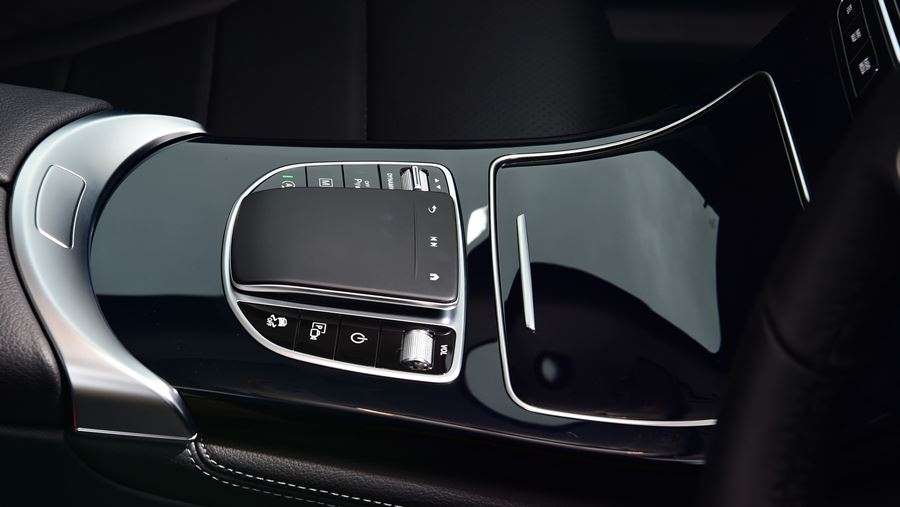
Servicing
Mercedes offers fixed-price servicing plans that cover all scheduled maintenance. You can pay all in one go up front or spread the cost over monthly instalments, which should be about £35 for a diesel GLC.
Mercedes GLC SUV - Engines, drive & performance
Its diesel engines are smooth, but the Mercedes GLC is more of a comfortable cruiser than an exciting driver’s car
SPECIFICATIONS
Engine choice is reasonably limited in the Mercedes GLC, but the two diesel options are very smooth on the move. All also come with four-wheel drive as standard – a system Mercedes calls 4MATIC. The GLC is almost car-like to drive and as comfortable and sophisticated as a luxury limousine – a happy consequence of sharing a platform with the C-Class saloon.
The GLC is at its best when driven in a relaxed, unfussed manner than on spirited back-road jaunts. Although all models have clever dampers as standard, they seem optimised for soaking up bumps and improving ride comfort rather than providing sharper responses. For a truly rewarding SUV driving experience, the BMW X3 and Jaguar F-Pace remain the cars to beat, although in the comfort stakes, the Merc trumps the Alfa Romeo Stelvio. The Volvo XC60 is even more comfortable still.
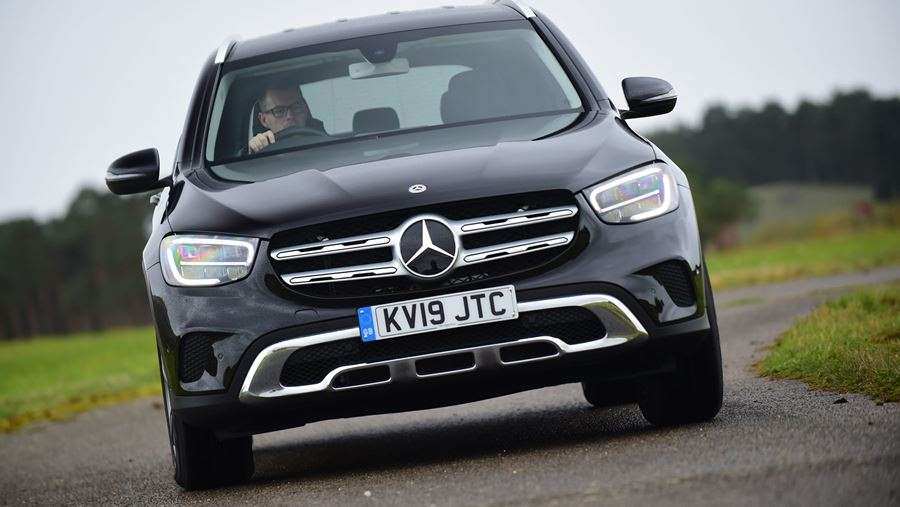
The GLC leans a little during hard cornering, but not so much as to feel unsettling and less than the Audi and Volvo. The steering is accurate enough, yet feels rather light and requires quite large inputs, so there’s little to encourage fast driving anyway. It’s far better to ease off the accelerator and cruise, which the Mercedes does very well.
All models use a smooth, responsive nine-speed automatic gearbox, which does a good job of keeping the engine revs low in the interest of fuel economy. The four-wheel-drive system is permanently engaged and uses traction control to ensure a firm grip on the road – any wheel found to be slipping is lightly braked and the engine's power is sent to the wheel on the opposite side to get you moving again.
Mercedes GLC diesel engines
Many people buying an SUV of this size will choose a diesel, and there are two available, badged 220 d and 300 d. Both are different versions of Mercedes' four-cylinder 2.0-litre engine, which is smoother and quieter than the 2.1-litre diesel it replaces, but still slightly more clattery than the best diesel engines found in rivals.
It might not appear like it if you look at the official performance claims, but most drivers will be satisfied with the slower 220 d, and it suits the GLC well. Mercedes claims 0-62mph times of 7.9 for the 200 d and 6.5 seconds for the 300 d, both of which will be more than fast enough for most SUV owners. That means our top pick is the cheaper 220 d, and it's a shame this isn't available with every trim level. Unlike the coarse old engine, the GLC 300 d we sampled was as smooth and quiet as a petrol, but with even more urge in real-world driving.
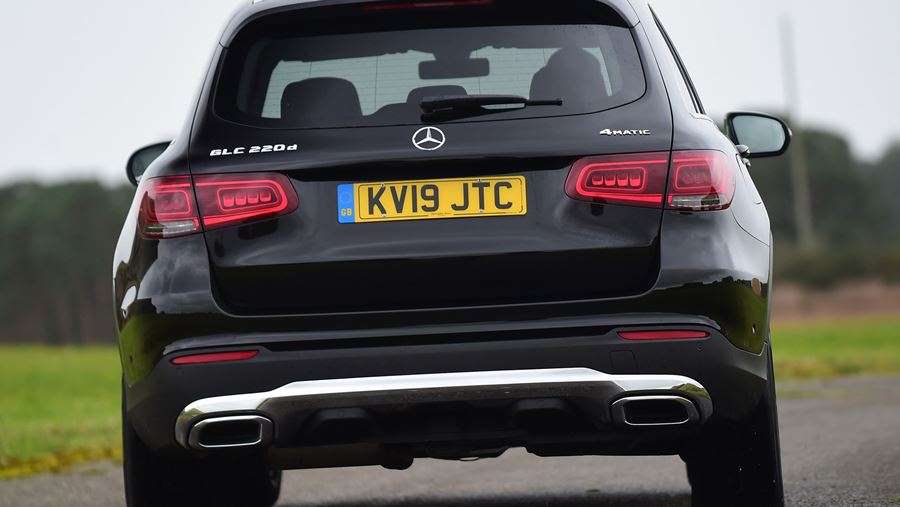
Petrol engines
Talking of petrol, the GLC 300 with 254bhp is available, featuring a new turbocharger, engine design and particulate filter all aimed at reducing emissions. It's also fitted with a mild-hybrid system that can recoup energy as the car slows down, then use it to aid acceleration. Acceleration from 0-62mph takes 6.2 seconds, while its top speed is 149mph. AMG models are even faster - the 43 model cracks 0-62mph in under five seconds, and the 63 and 63 S reduce this to four seconds or less. With the speed limiter removed, the GLC 63 S will carry on all the way to 174mph.
Hybrid engine
Most plug-in hybrids use a petrol engine, but the GLC 300 de has a diesel engine for long-range economy. The combination produces 302bhp, so the PHEV is quick too - 0-62mph takes 6.2 seconds. For 2021 the petrol-based GLC 300 e plug-in has also arrived, and it's even faster, taking just 5.7 seconds to get from 0-62mph.
Its 2.0-litre turbo petrol engine and electric motor produce a combined 316bhp, and it does a good job of prioritising electric power when the battery is charged. In this mode it's almost silent, and even when the petrol engine kicks in it's almost imperceptible. There's also a clever regenerative braking system that can be adjusted using the paddles behind the steering wheel or left to work automatically based on the road and traffic.
Mercedes GLC SUV - Interior & comfortThe
Mercedes GLC has a well built interior and even the entry-level model has loads of standard kit
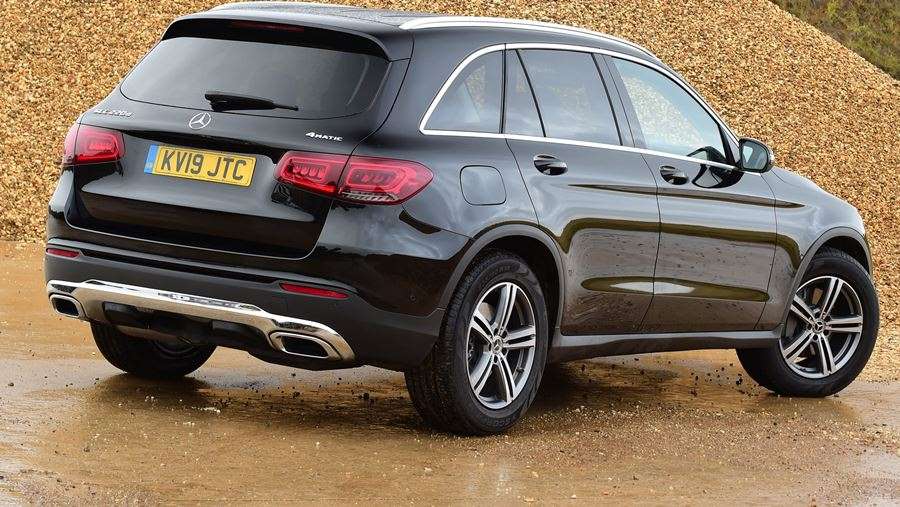
SPECIFICATIONS
The Mercedes GLC boasts an impressive, high-quality dashboard and interior design that’s more luxurious and up-to-date than what you’ll find in many rivals. All models are well equipped, but you’d expect them to be considering the GLC’s price. We'd recommend choosing an AMG Line Premium trim or above to really experience all the GLC has to offer.
Thanks to a honed suspension setup and using some parts from the Mercedes C-Class saloon, the GLC is very comfortable on the move whether on the standard steel springs of the Sport or the optional AIRMATIC system. Road and wind noise are minimal and a clever crosswind prevention system helps to keep the GLC stable at high speeds. Even the more sportily tuned AMG Line models maintain the comfortable ride of the Sport, although the wider tyres do kick up a little more noise from the road.
Mercedes GLC dashboard
The GLC shines when you sit behind the wheel. The entire design looks like it’s been lifted straight from the C-Class saloon, as there’s loads of solid metal switchgear and clear instruments. The middle of the dashboard is dominated by a single piece of wood or gloss-black veneer that starts from just underneath the infotainment screen and swoops down to connect to the centre console.
The classic air vents look like they’ve been taken straight from a vintage aircraft and the control for the sat nav and infotainment is the only control interruption on the centre console. The steering column-mounted gear selector is a little strange to get used to, though. It's also a shame that the standard analogue gauges and central trip computer look dated compared with the digital instruments fitted in AMG Line Premium trim.
Equipment
The GLC now comes in AMG Line trim as standard but extra kit can be added by upgrading to Premium and Premium Plus versions. Even the entry-level model has a comprehensive amount of equipment: a reversing camera, Parktronic, a powered tailgate, rain-sensing wipers, LED headlights, leather seats, automatic climate control, sat-nav and DAB radio are all standard.
The AMG Line Premium version throws in a sports bodykit and interior makeover, sports suspension, 20-inch AMG alloy wheels, adaptive headlights, ambient lighting and a 12.3-inch digital instrument display. Premium Plus is even more lavish, thanks to a panoramic sunroof, Burmester stereo system, keyless entry, 360-degree camera view and memory front seats and steering wheel.
Options
The Driving Assistance package is worth considering if you spend a lot of time behind the wheel, adding blind-spot monitoring, lane-keeping assistance, adaptive cruise control and a system that applies the brakes if it thinks you're about to hit the car in front. Air-suspension can also be fitted, further improving the ride quality. If you plan on towing, an official tow bar costs around £750.
Mercedes GLC SUV - Practicality & boot space
The Mercedes GLC provides loads of storage areas and its boot is a decent size, if not class-leading
SPECIFICATIONS
Considering it’s an SUV, the GLC is easy enough to get into, as its doors open nice and wide. The steering wheel and driver’s seat have plenty of adjustment and there’s plenty of room in the back. Boot space is good, if not class-leading, but the plug-in hybrid offers noticeably less due to its batteries taking up some of the luggage room.
Mercedes GLC interior space & storage
The GLC offers a decent amount of leg and headroom in the rear, but the transmission tunnel can eat into space for the middle-seat passenger.
Interior storage is good, thanks to a generous space in the front armrest and a deep cubby in front of the infotainment dial in the centre console. The door bins can all hold bottles and rear-seat occupants get their own air ventilation and an armrest that features a storage cubby and two cup-holders.
Boot space
Total boot volume is about on par with a lot of the GLC’s rivals. The 550 litres on offer is the same as what you get in the BMW X3 and equal to the Audi Q5’s boot. However, it’s less than what’s available when you fold down the Land Rover Discovery Sport’s third row of seats. The GLC’s rear seats fold in a 40:20:40 configuration with the pull of a lever, offering extra versatility and more room in the boot if needed.
In the boot you’ll find the usual range of neat practical touches like anchor points for smaller items and a cubby either side to store bits and bobs. The boot itself is square and the opening is large, so getting awkwardly shaped items in should be a breeze, especially with the power-operated tailgate.
Compared to the 550 litres you get in petrol and diesel cars, the PHEV’s boot is a bit smaller at 395 litres. That’s only 25 litres more than in the A-Class hatchback but at least the boot floor is flat, unlike the annoying step in the boot of the E-Class plug-in. It also benefits from underfloor storage, so you can keep your charging cables separate from your shopping.
Towing
All diesel GLC models can tow 2,500kg – more than most versions of the Land Rover Discovery Sport, and matching the D240. Both the GLC 300 de and 300 e can also tow up to 2,000kg, which is an impressive amount for a plug-in hybrid.
Mercedes GLC SUV - Reliability & safety
There’s an impressive amount of safety technology as standard, but there could be questions about long-term reliability of the Mercedes GLC
SPECIFICATIONS
The Mercedes GLC has an impressive suite of safety kit, which can be added to with optional equipment like adaptive cruise control. Although owners expressed reliability concerns in our 2019 Driver Power customer satisfaction survey.
Mercedes GLC reliability
Looking at the 2020 results of our Driver Power owner satisfaction survey, Mercedes as a brand came a disappointing 28th out of 30 manufacturers, with 16.5% of respondents reporting a fault within the first year of ownership.
Things were even worse for the Mercedes GLC in particular, because despite coming a reasonable 61st out of our top 100 cars overall in our 2019 results, it came dead last for reliability. A worrying 44% of owners reported at least one fault in the first 12 months, including engine, electrical and interior trim problems. The GLC didn't appear in our 2020 results. Hopefully Mercedes will have identified these teething problems and recified them as part of the model's facelift.
Safety
Along with the standard spread of airbags and traction control, the GLC has an advanced stability program, Mercedes’ crosswind-assistance technology and a collision-prevention system. An optional semi-autonomous driving system is available. This takes adaptive cruise control a step further, maintaining a safe distance from the car in front, steering the car if you drift out of your lane and braking automatically if it detects an imminent collision.
All this led to the Mercedes GLC scoring the full five stars when it was crash-tested by Euro NCAP at the end of 2015. It scored an impressive 95% in the adult occupant protection category, as well as 89% in the child occupant protection category.
The collision-prevention technology can get a little over-zealous, as it tends to flash a warning at you even when you’re a safe distance behind the car in front. Fortunately, it’s relatively easy to deactivate if you find it to be more of a hindrance than a help when on the move.
(carbuyer.co.uk)
New and unusual Honda Civic finally discovered (PHOTO)
Finally, all the details of the 11th generation Honda Civic Sedan are known, which brings a lot of state-of-the-art technology and unusual design. He is unusual because he is no longer overly aggressive. The new Civic will strive to remain one of the best-selling cars in the United States for the last 50 years.
After a short announcement from Honda in April, which was accompanied by only one photo of the new Civic, the 11th generation of this model was finally presented in a four-door sedan version.
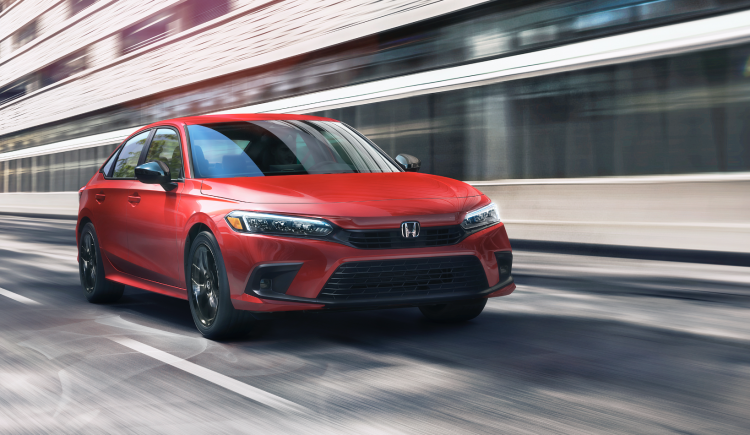
It is technologically refreshed, and the main goal of the company is for the new Civic to continue its success story as one of the best-selling models in the USA, writes Auto Klub.
To achieve this, Honda returned to the original simplicity of design, which was a huge success in the 70's.
And indeed, the new Civic has a bit of design sharp lines but already looks very clean. To simplify the design, Honda has moved the windshield frame back by two centimeters, which makes the bonnet look longer and has classic proportions.
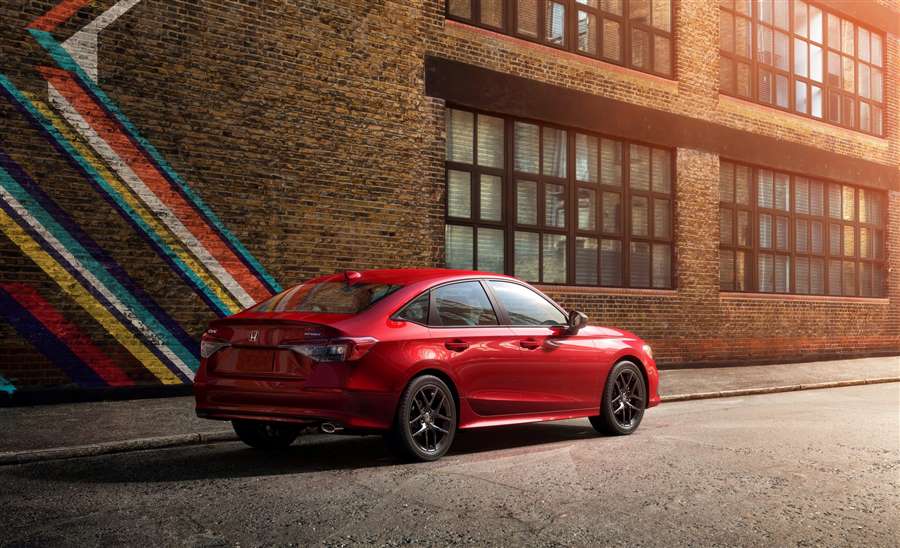
The sharp line that cuts through the body and enters the rear lights of the Civic has been deliberately retained. In addition, the sedan looks much wider due to the stronger "shoulders" at the rear and the wide-set LED lights.
"All this contributes to a car that is not burdened with the weight of unnecessary design tricks," they say in Honda. Three new colors will also be available: Meteorite Gray Metallic, Sonic Gray Pearl and the exclusive Morning Mist Blue Metallic.
In the cabin, the new Civic offers a 10.2-inch digital instrument panel and a 7-inch infotainment system as standard, which is much larger than the dimensions of the outgoing model.
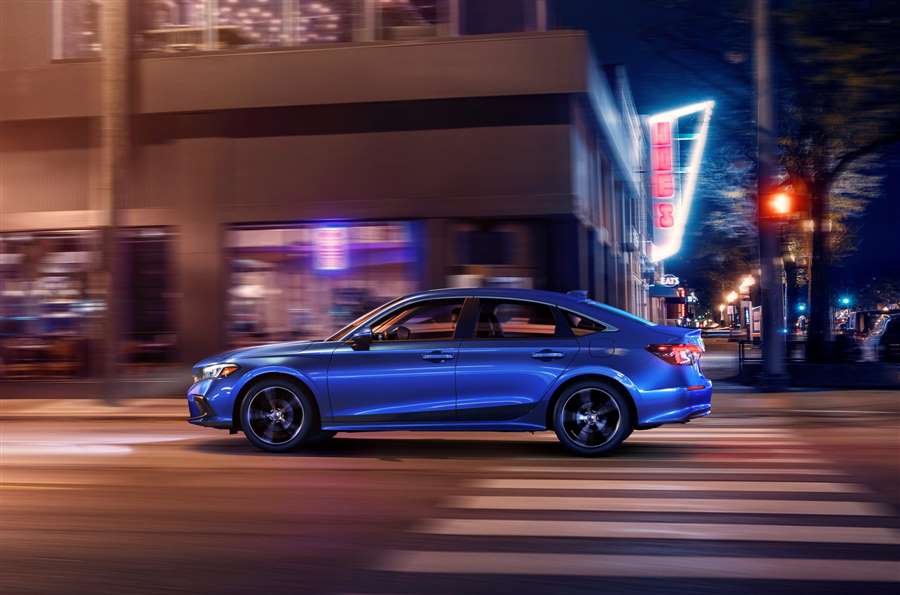
As part of the Man Maximum / Machine Minimum design philosophy, Honda has decided to retain physical controls for certain functions, such as air conditioning and an audio system that can also offer 12 Bose speakers.
When choosing the material in the interior, practicality was taken into account, so that you forget the "piano black" details on which fingerprints remain. Instead, a mesh honeycomb design was used, which looks clean and elegant, and hides ventilation openings that would disrupt the harmony of the front panel.
Moving the windshield provided better visibility outside the car, while longer and wider dimensions contributed to more space for passengers' heads, legs, hips and shoulders, so it can be said that the new Civic is more spacious than ever.

The wheelbase is 3.5 centimeters longer, which contributes to better stability and a smoother ride.
In addition, the strategic use of high-strength steel and aluminum, torsional strength is eight percent better than the older model. And with all that, the weight of the vehicle is reduced.
Today, all new cars have many assistance systems, and the Civic calls its package of active safety technology Honda Sensing, which has been upgraded with a new camera that provides a wider field of view, as well as a system that recognizes pedestrians, cyclists and other vehicles. Cruise control has been improved with more natural braking and faster reaction, as well as a lane keeping system.

We offer two four-cylinder engines - a 2.0-liter atmosphere with 160 hp (118 kW) and 187 Nm of torque, as well as a 1.5-liter turbocharged engine that produces 182 hp (134 kW) and 240 Nm, which is 7 HP more than the same engine in the last generation. In addition, fuel consumption has been reduced.
The new sedan should go on sale this summer, and it will be produced at Honda's factory in Ontario, Canada. A compact version is expected in a few months. However, the prices have not been announced yet, but a little more than 21,250 dollars is expected, which is the price of the current basic model from 2021.
New Toyota Mirai 2021 review
We get behind the wheel of the second-generation Toyota Mirai hydrogen fuel cell car
Verdict
Toyota has learned a great deal about fuel cell cars since the first Mirai was released back in 2014 - and it shows. The new model is improved in pretty much every measurable way, and most subjective ones, too. While limited refuelling options, a cramped interior and a high purchase price mean the Mirai won’t be for everyone, it’s a rolling proof of concept that shows hydrogen will play a big part in a zero-emission future - just maybe not for passenger cars.
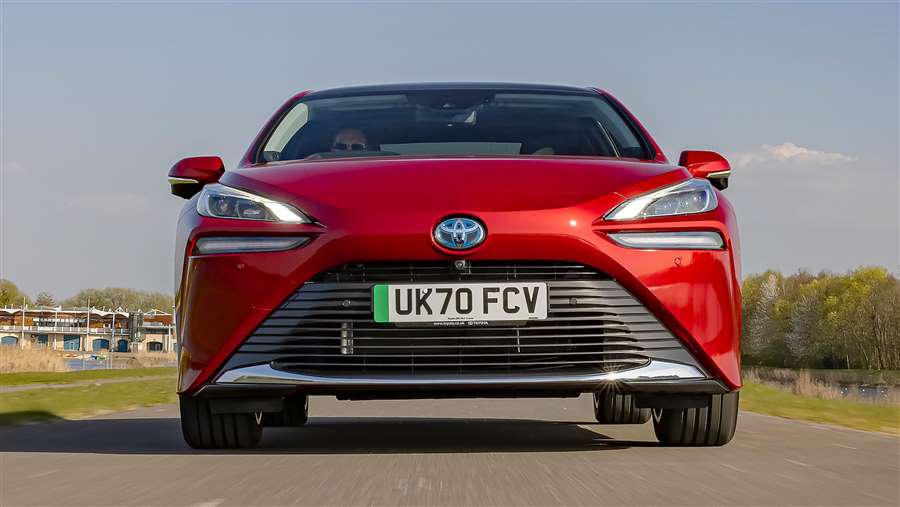
Dare to search out the type of pub monologue given by a person with the confidence only a few drinks can bring, and you’ll hear that the future of motoring isn’t in electric vehicles, but hydrogen.
Here, then, is the all new Toyota Mirai, powered by that very fuel that’s seemingly always been on the cusp of the mainstream. It’s the sleeker, more handsome second-generation model of the brand’s hydrogen fuel cell car, and it proves that the world’s most abundant element can play a huge part in our zero-emission future - just not necessarily for cars.
Hydrogen fuel cells: do hydrogen cars have a future?
Let’s start with how the Mirai works, because this is still, in essence, an EV. A fuel cell works by passing hydrogen across an anode, which splits the atoms into protons and electrons. The electrons then pass through a circuit to generate a flow of electricity, which in turn charges a small lithium-ion battery that, like a regular EV, drives an electric motor.
A clever chemical reaction that sees hydrogen react with oxygen from the atmosphere means the only byproduct is water, as a puff of vapour from the exhaust.
All of this magic happens under the Mirai’s long bonnet. Advancements in the tech since the first-gen car was launched mean that the fuel cell is 50 per cent lighter and physically smaller, yet it makes 12 per cent more power, so the Mirai’s motor now generates 180bhp.
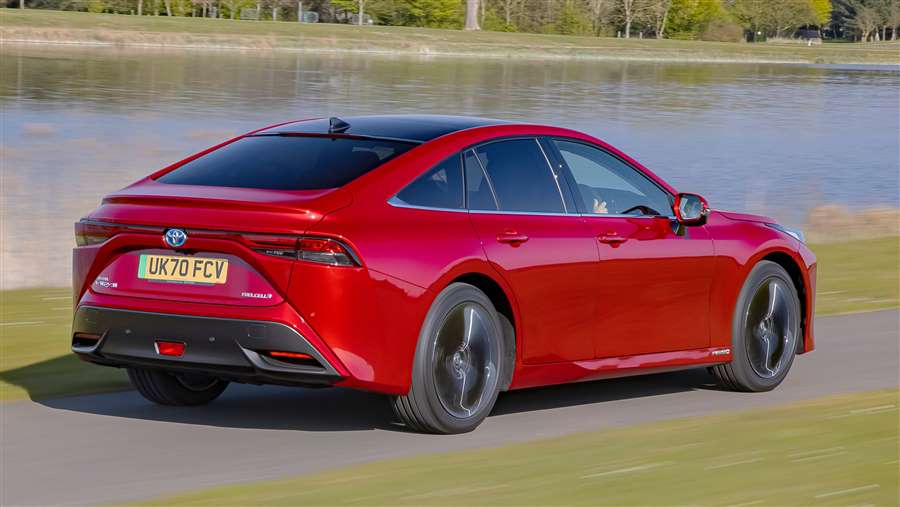
Progress in the Mirai is serene. A nine-second 0-62mph time is a world away from the mind-bending speed of some EVs, but the acceleration feels smooth and linear. Put your foot to the floor, and there is a slight delay before the Mirai jumps ahead, a process accompanied by a sci-fi hum that’s distinct from any other pure-electric car.
The Mirai is set up for a relaxing drive, but that’s not to say it feels stodgy. The ride is forgiving - even on top spec Design Premium Pack trim’s 20-inch wheels - yet the car is neatly balanced front to rear, so it feels stable and predictable. At speed, the only obvious noise is the subdued tyre roar.
So what are the benefits of hydrogen as a fuel source? Well mile-for-mile, it’s significantly lighter than a battery. Whereas a Tesla Model S promises 390 miles from a battery weighing roughly 500kg, the hydrogen that fills the Mirai’s tank weighs just 5.6kg and will carry you for an official range of 400 miles. It means that, overall, the Mirai tips the scales at 1,900kg - on par with a combustion vehicle of a similar size.
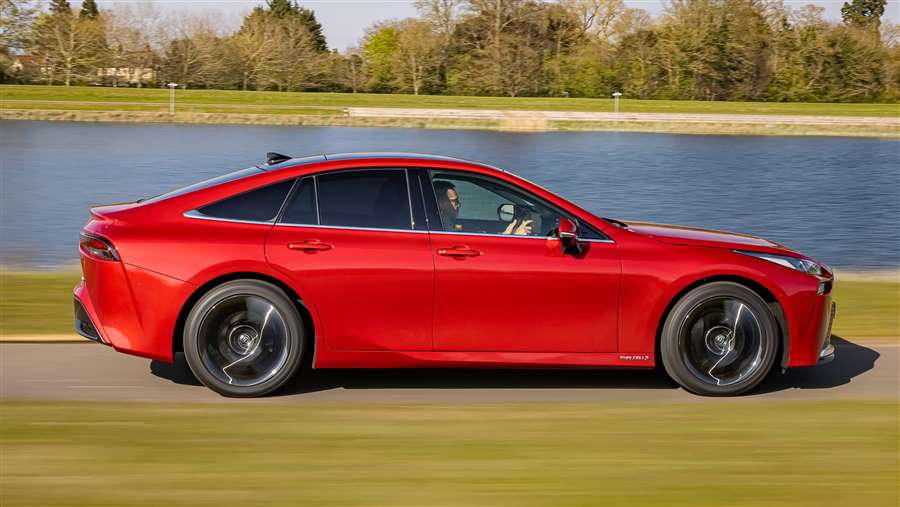
Toyota says that the Mirai consumes 0.89kg of hydrogen every 62 miles; in the UK, a refill costs about £10 per kg. Our test drive covered more enthusiastic driving than most will subject it to, and the Mirai consumed 1.17kg per 62 miles - equating to about £56 for a 300-mile real world range. That’s a similar cost to a petrol car achieving 32mpg.
Of course, filling a hydrogen car represents a stumbling block for the technology. While EV charge points continue to pop up at a relentless pace, the total number of hydrogen filling stations in the UK stands at 14. There are a couple of big stations under construction, but the fuel is definitely more scarce.
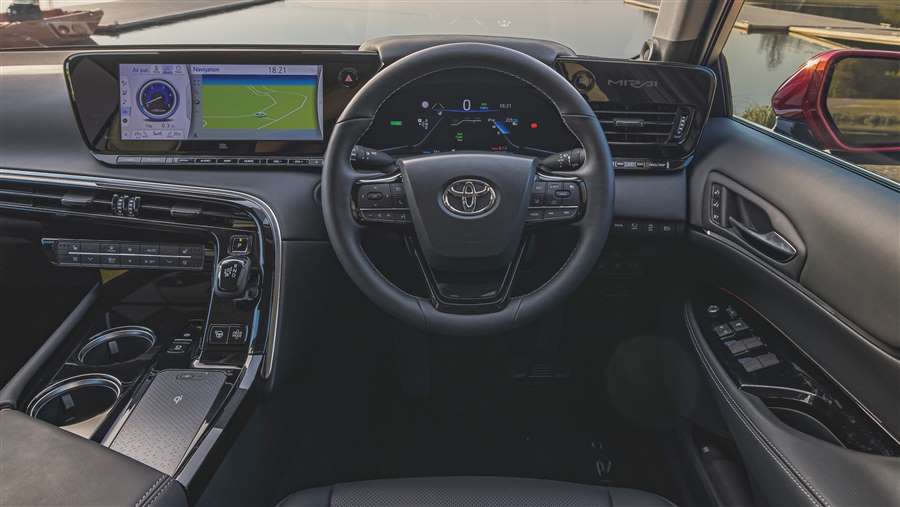
To create hydrogen, it needs to be separated from water via electrolysis, compressed and liquified and, if this process isn’t done on-site, transported to a refuelling station, where the fuel cell then uses more energy to generate its electrical charge, so it’s not the most energy-efficient process.
A full EV effectively skips the admin, taking electricity from the national grid. Of course, there are other factors, such as the sourcing of raw materials, but fuel cell vehicles still need lithium, too.
And while 5.6kg of hydrogen goes a long way, packaging the tanks needed is tricky. The Mirai has three. The largest is mounted within the spine of the car in the floor, which creates a high central tunnel inside. Further tanks are located fore and aft of that, squeezing the cabin from either end. As a result, rear legroom is barely any better than most superminis, and the boot offers just 321 litres - this in a car with a similar footprint to an Audi A7.
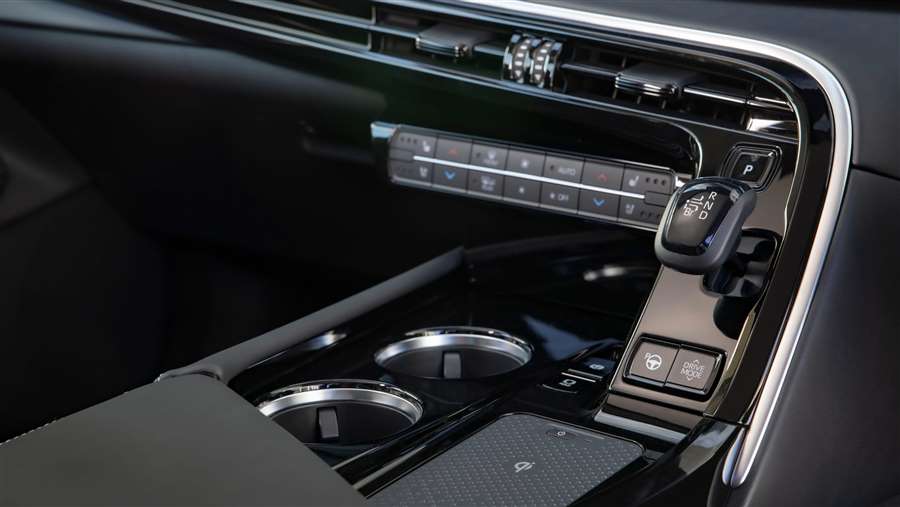
Otherwise, the cabin is well-finished and packed with tech. There’s a huge infotainment screen, a digital instrument panel and a 10.1-inch head-up display. All four seats are heated and cooled, while back-seat occupants get a fold-down centre armrest that houses controls for entertainment and climate functions.
Despite being more powerful, more luxurious and better equipped than before, prices now start from £49,995 - the best part of ten grand less than the first Mirai. This top spec Design Premium Pack costs £64,995. That’s still strong money for the performance, but there’s always a price to pay for being an early adopter.
By Toyota’s own admission, the Mirai is essentially a rolling research lab. It proves the tech works, though its finest application is unlikely to be in cars, but in commercial vehicles. Refuelling stations can be built at transport depots topping up lorries and buses at a speed and with a range that - currently - lithium-ion batteries just can’t compete with. The weight saving of hydrogen relative to a big battery is already significant in a car - it would be enormous once expanded to the size of an HGV.

